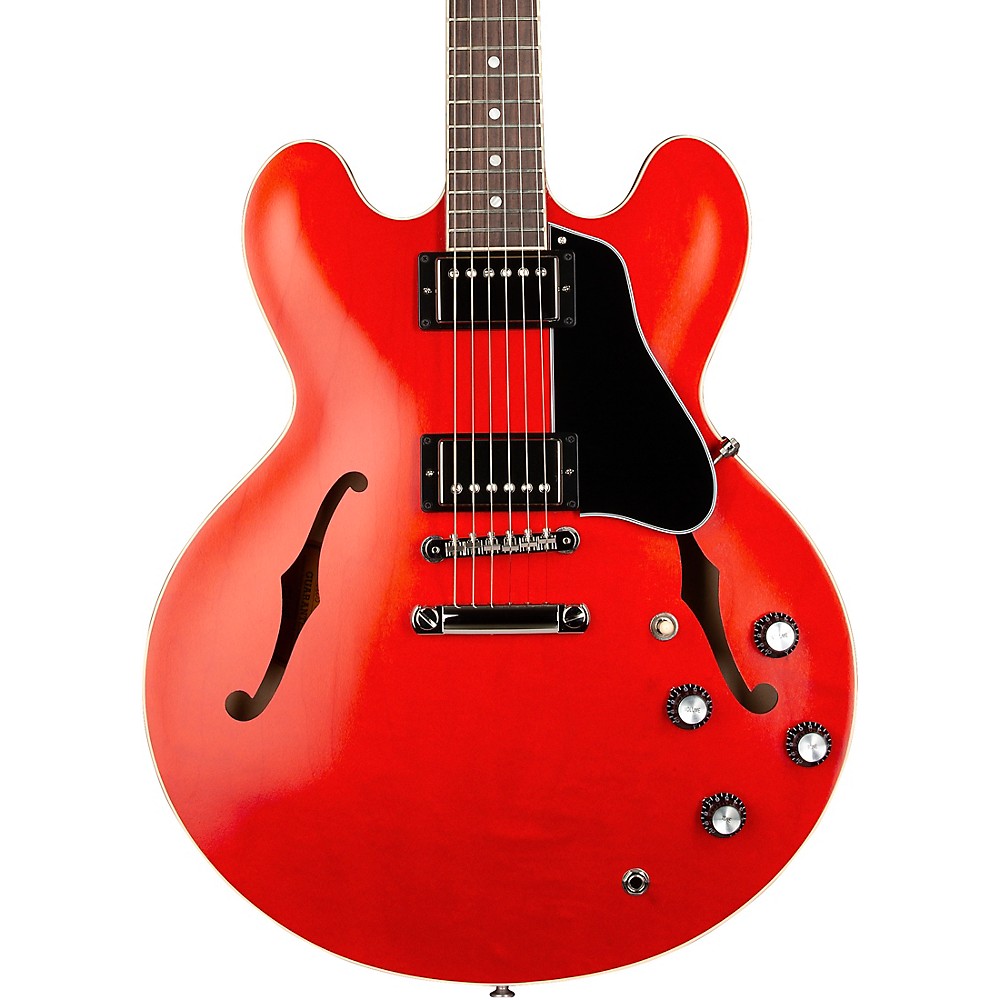Music is the universal language
“Glory to God in the highest heaven, and on earth peace to those on whom his favor rests.” - Luke 2:14
Premier Guitar
A Guide to Shrapnel Shred
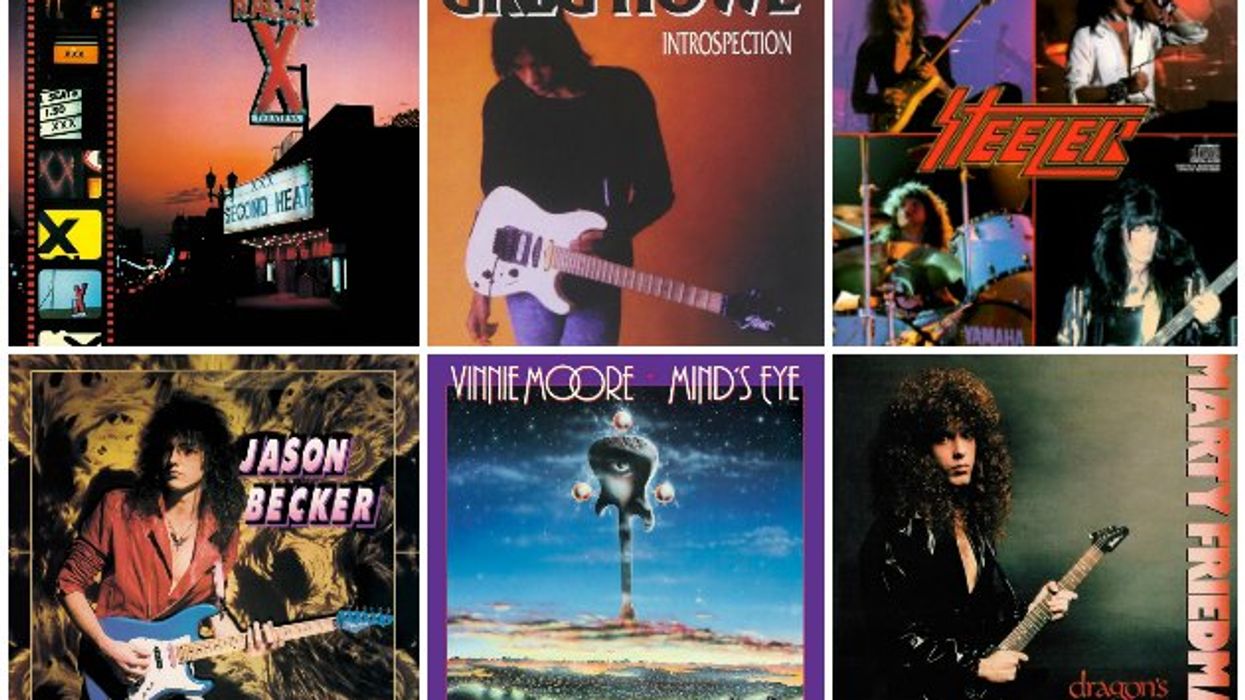
Chops: Advanced
Theory: Intermediate
Lesson Overview:
• Work through sweep arpeggios in the style of Jason Becker.
• Add more chromatic notes to your improvised solos.
• Make your riffs more compelling with unexpected rhythmic subdivisions.
Click here to download a printable PDF of this lesson's notation.
Shrapnel Records introduced the world to some of the most virtuosic rock and metal guitarists to have ever plugged into a high-gain amp. Starting in the ’80s, an era that has subsequently become infamous for guitar gods, Shrapnel’s founder Mike Varney carefully selected the cream-of-the-crop players for his unique record label.
Some Shrapnel alumni are best known for sweep picking, others for insane alternate picking, and yet others for emphasizing legato fretwork. But all of them are known for playing a lot of notes in a very musical way. What made many of these players great, in my opinion, is that each took a unique approach to playing and writing within the fairly specific “shred” genre.
Want to acquire some tricks of their trade? Let’s take a look at key ideas and techniques used by several of Shrapnel’s heaviest hitters.
Most people associate Shrapnel guitarists with technical lead playing, but before we go there let’s first visit the often-overlooked art of playing rhythm. In my opinion, Paul Gilbert and Bruce Bouillet of Racer X were absolute masters of creating rhythmically exciting and unexpected metal riffs. These were often based on strong rhythmic hooks that included subdivisions and interwoven exchanges, and took surprising aural twists and turns.
Ex. 1 is a Racer X-style riff in A minor that illustrates the basic idea of taking one rhythmic pattern and throwing in surprise subdivisions. This riff’s main rhythmic pattern is based on three-note groupings of 16th-notes. In the first measure we encounter a new subdivision on beat 4. Hear how those 32nd-notes surprise the ear? It’s a great example of what Racer X was known for.
Another example of this effect is in the riff’s second fill. We have a 16th-note triplet run to wrap up the first repetition (starting on the “and” of beat 3 in measure 2), and again, the change in subdivision from the main 16th-note pattern creates an additional rhythmic twist.
Click here for Ex. 1
Now that we’ve had a dose of rhythmic content, let’s shift over to the kind of lead playing that makes many listeners’ jaws drop. Because he introduced pop and R&B-inspired chord changes and funky rhythms to what was fundamentally a hard rock and metal label, Greg Howe is arguably one of the most distinctive Shrapnel artists. To make things even more interesting, he favored an innovative tapping technique and infused his playing with chromatics.
Inspired by the record Introspection, Ex. 2 is a Greg Howe-style lick over a series of dominant 7 chords. Hear how the chromatics are interwoven between E7 and B7 chord tones on the weak parts of the beat? This is a common jazz guitar technique, but it’s made very Howe-ish thanks to Greg’s grooves, feel, and note choices.
Next over A7 comes one of Greg’s most famous tapping techniques. This line also demonstrates his “hammer-on from nowhere” technique, which means that the hammer-on note isn’t approached by a previously picked note. Finally, we have another of Greg’s famous tapping techniques over the F#7. Here, we take three-note-per-string scales and instead of picking every note or playing full-on legato, use a hammer-hammer-tap pattern to cover the ascending phrase.
Click here for Ex. 2
Another Shrapnel powerhouse is Tony MacAlpine, who is famously known for his blazing picking and his blend of classically inspired themes and contemporary instrumental music. Ex. 3 pays tribute to his approach to arpeggios.
The opening phrase is one of my favorite Tony-isms. We’re creating a major 7 arpeggio, in this case Dmaj7, by only using the lowest two strings. Keep in mind that there’s absolutely no picking here—it’s strictly legato and tapping. But the real interesting thing about this kind of line is the context in which Tony often uses it. Here, we’re in a Bm tonality, so we can use a D major arpeggio (Bm’s relative major) and still stay in the key.
Click here for Ex. 3
We’ve explored a variety of tapping and arpeggio ideas, but haven’t yet encountered one of the most common staples of the Shrapnel guys: alternate picking licks! Many of the Shrapnel guitarists are well known for playing long, scalar runs in which they pick each note. If used wisely, this can be one of the simplest ways to enhance your playing, as these runs are mostly pattern-based and primarily built on the three-note-per-string scale fingerings.
A simple alternate-picked line in B minor, Ex. 4 starts with a six-note scale shape that’s copied across three octaves. You’ll find this fragment (the first three beats of the first measure) on many Shrapnel albums. Keep in mind that strict alternate picking is crucial for the accuracy and cleanliness of a lick like this, so be sure to practice it slowly.
Because these lines work so well in the three-note-per-string fingerings, they’re often conducive to some sort of triplet subdivision. The kicker with such licks is that they’re very pattern-based and can end up sounding too much like an exercise. Use them wisely and musically.
Click here for Ex. 4
And last but not least, what would a column on Shrapnel be without a mention of the legendary Jason Becker? For dedicated shredders, his playing and spirit need no introduction, but if you need one, check out this trailer for the excellent documentary Not Dead Yet.
Ex. 5 is a workout in Becker-style sweep arpeggios. One point that was unique about Jason’s particular approach to sweep picking is that he extended certain arpeggio shapes further than other players did. In this example, all of the shapes extend down to include two notes on the 5th string. It’s fairly rare to see the Bm and E shapes extend down that far, but that’s part of Jason’s nuanced magic. The key to successfully playing sweep arpeggios lies in the picking pattern. It’s always a specific, non open-ended pattern that isn’t as simple as just constant downstrokes and upstrokes. A hammer-on or pull-off is included every time there’s two notes played on the same string.
Click here for Ex. 5
Keep in mind that playing anything cleanly and accurately lies in practicing very slowly, in time with a metronome. These guys were all masters of fast playing, but I believe they were standouts because they used their chops in clever and musical ways, and that composition was their first priority. So when you’re sitting down with your metronome to blaze through these licks, just remember that music comes ahead of technique.
Racer X
This blazing live performance of Racer X’s “Scarified” from 1988 illustrates how Paul Gilbert and Bruce Bouillet varied the rhythms within their warp-speed riffs.
Greg Howe
Greg Howe improvises an incredible solo over his tune “Come and Get It.” Check out 0:45-0:48 for a great example of one of his signature tapping techniques.
Tony MacAlpine
Here’s Tony MacAlpine playing “Pyrokinesis” with an excellent view of his fretboard. Marco Minnemann plays the drums on this track and MacAlpine plays everything else. Look for his tapped arpeggios sequences and notice how he weaves them into both the melody and the solo.
Jason Becker
The legendary Jason Becker performs a dazzling mix of feisty, extended-range arpeggios in this clip from a guitar clinic in 1989.
Kiesel Unveils Kyber Headless and Masvidalien MIII Models
Kiesel Guitars has introduced the two newest models in the company’s iconic line of custom-built instruments: the Kyber Headless and Masvidalien MIII now join the lineup of Kiesel’s premium US-made instruments.
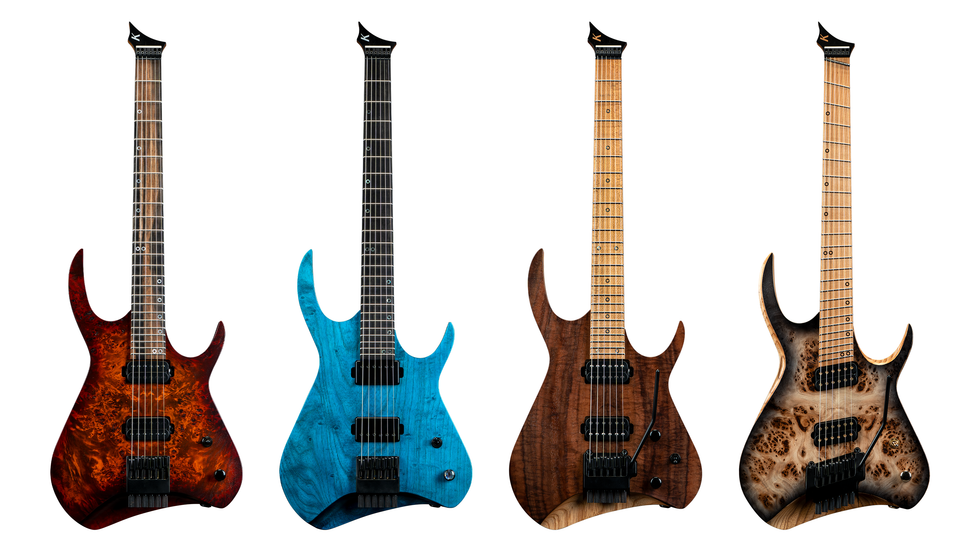
Designed to excel in a variety of musical styles, the versatile Kyber Headless is available in 6, 7, and 8-string configurations, standard or multiscale. Key features include:
- 7 different body woods for customization
- 25.5” scale length, 15 different fretboard woods for customization, 24 frets
- Over 100 different pickup configurations
- Kiesel-Designed locking nut, headpiece for hanging, optional body scoops
The Masvidalien MIII is the debut Kiesel signature model from Paul Masvidal, guitarist and composer known for his work with Cynic, Death, Æon Spoke, and Mythical Human Vessel.
Built in Kiesel's California factory, the MIII was designed with strength, resonance, and playability at its core. Inspired by Kiesel's Kyber model, which Masvidal was already connected to, the MIII began as a natural extension of that instrument but quickly evolved into something uniquely its own, a hybrid guitar that expands on the Kyber's spirit and opens new creative ground.
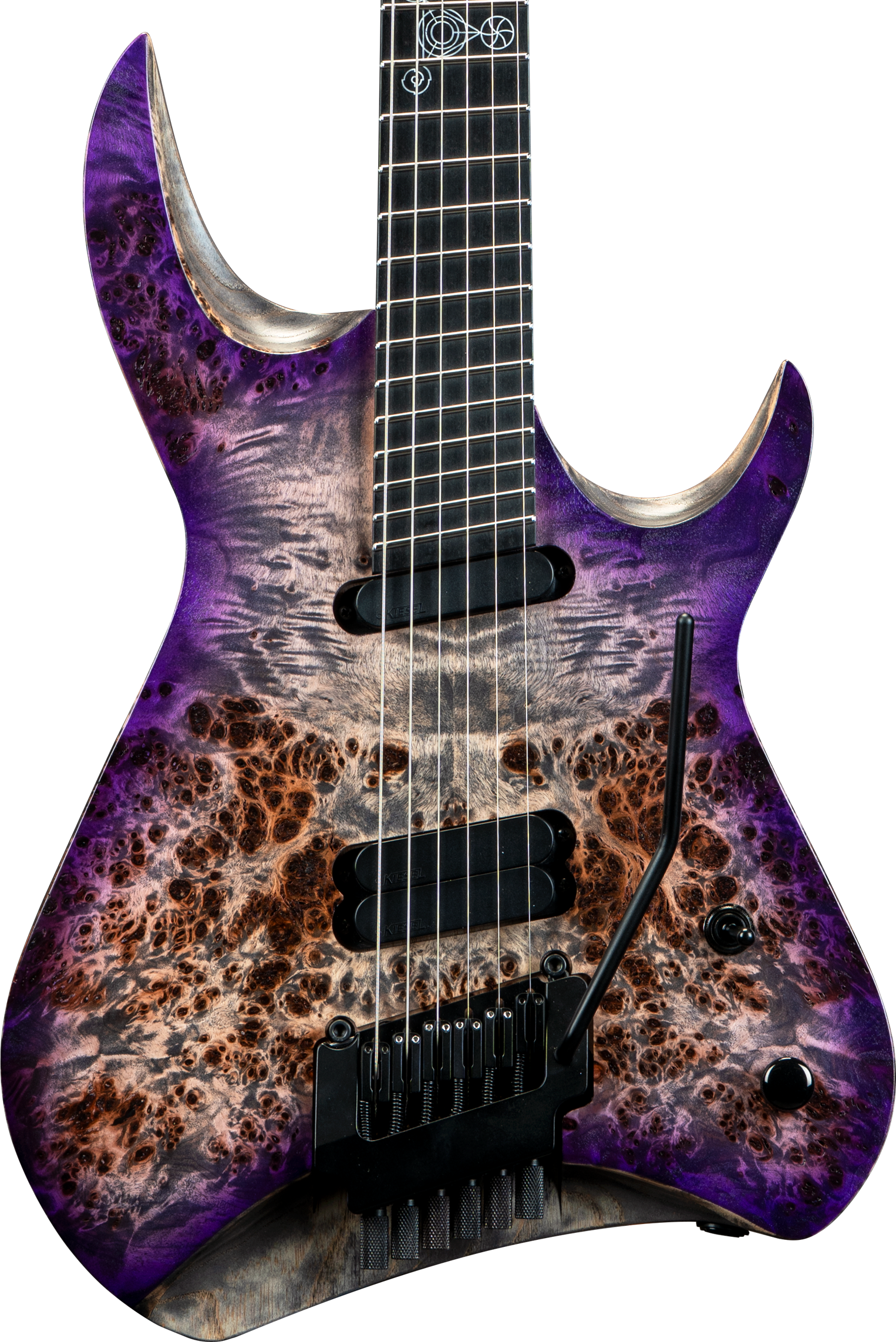
Key features include:
- Woods: 5A Poplar top with a Swamp Ash body, Buckeye top with a Roasted Swamp Ash body
- 25.5”-26.5”, Fretboard woods: Ebony, Richlite Diamond, Roasted Maple, Royal Ebony, and Roasted Birdseye Maple, 24 Fret
- The brand-new Focus pickup, a humbucker made from two blade-style single coils that offers tighter and more precise tones
- The Hybrid carbon fiber/wood neck, the Barbury Castle Crop Circle inlay, Headpiece for hanging,
Like other Kiesel models, the new Kyber Headless and Masvidalien MIII are available in a wide range of options for unique customization. Players can select their favorite finish, tonewoods, electronics and hardware to create the guitar of their dreams…expertly crafted in Kiesel’s Southern California custom shop.
Kiesel’s new Kyber Headless is available for street pricing starting at $1,599. The new Masvidalien MIII is available for street pricing starting at $3,199. For more information visit kieselguitars.com.
Steve Morse Band Announces Brand-New Studio Album
The Steve Morse Band has announced details of their brand-new album, Triangulation, which will be released on November 14 via Music Theories Recordings (Yngwie Malmsteen, Ayreon, Paul Gilbert, Vandenberg). To celebrate, they have unveiled the official video for their new track, “Break Through.”
“Break Through” is the first new music since the release of 2009's Out Standing In Their Field. Talking about the track, Steve Morse shares, "This may start with a guitar riff, but the bass carries the melody. It's just a great feel to play over, and a positive vibe to start the album."
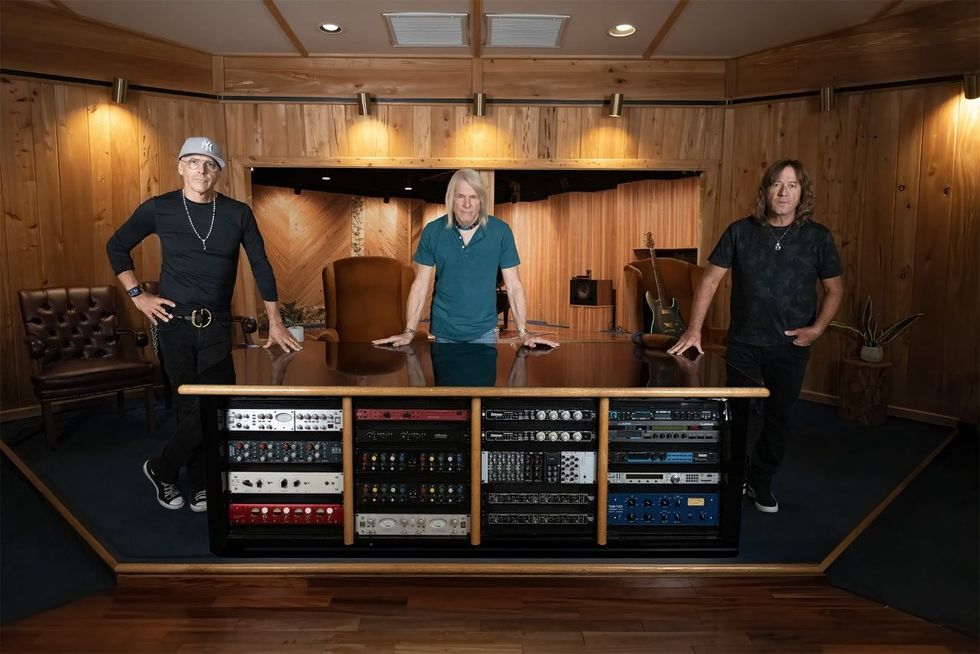
Whenever we think of the greatest guitar players of all time, Steve Morse is a name that's always in the conversation. This album sees Morse teaming up once again with Dixie Dregs, Steve Morse Band, and Flying Colors bassist Dave LaRue, with Van Romaine [Steve Morse Band/Enrique Iglesias] joining on drums.
Steve beams, "Dave and Van have been the bedrock of this trio, and this recording shows why. These guys are unique and incredible musicians on their own, and together, our chemistry is magical. While making the album, we played together, working through parts, riffing off each other, and collaborating on arrangements. I'd bring an idea, and hear it instantly — and then hear it improved. We made this album together, and you can hear it."
There are also some stellar guest features, from Eric Johnson's majestic contributions to “TexUS” and John Petrucci bringing his inimitable progressive metal thunder and, of course, Kevin Morse joining his father on "Taken by an Angel.".
Executive producer Bill Evans noted, “The compositions are among Steve’s best. And audiences can finally hear every detail of Van and Dave’s performance…the band’s collaborative musicality.” Steve added, “Brian captured me brilliantly, and Carl Roa created more sonic and performance clarity than we’ve ever had.”
Morse started his career in the mid-1970s, playing mind-melting jazz-rock with The Dixie Dregs, which earned him multiple Grammy nominations in the process. The following decade, he formed the Steve Morse Band, grabbing an additional Grammy nod, and joined arena heavyweights Kansas, before being recruited by rock and roll originals Deep Purple in 1994. And despite being in one of the world's biggest bands, he continued to innovate in other projects like Living Loud, Angelfire, and Flying Colors – as well as guitar supergroup G3 – showing the world just how much versatility there was in those magic fingers. He announced his departure from Deep Purple in 2022, choosing to care for his wife, who passed away in 2024, by that point having become their longest-serving guitarist.
Naturally, the last few years have been the most personally traumatic of his life, which is perhaps why this year's creative comeback with the new Steve Morse Band album Triangulation embodies the spirit of a master returning to do what he does best. Its nine tracks are a thrilling ride through the mind of a musician who seemingly knows no bounds, crossing over into a cornucopia of sounds and styles from funk and blues to classical and metal.
“The album title Triangulation comes from the concept of aviators, navigators, and sailors looking at two points to pinpoint their exact location at a specific moment in time,” says Steve. It's a geographical concept that also applies to human life on a broader level, and given the journey Morse has been on in recent years, it's only natural that he's been on a path of self-discovery and reflection.
Perhaps the most poignant of the nine tracks is "Taken By An Angel" – a tribute to Steve's beloved wife Janine. Steve left the music world behind to care for her, remaining by her side until her final days. "That song is new territory for me," explains Morse. "It was put together for my late wife's memorial service, with my son Kevin playing along. It brought tears to many folks' eyes because Janine was a huge part of my life and career. People knew her from the Steve Morse Band tours. She was the smiling face opening CDs for me to sign, selling t-shirts, listening to people's stories in the crowd, and taking photos for VIP visits."
After all the heartache and anguish of the last few years, you can't help but feel grateful Morse is once again ready to share his creative genius with the world around him. Given his stature among the guitar community – often lauded as 'your hero's hero' in the same way people spoke about Jeff Beck – his creative return marks a new phase of inspiration and brilliance. In that sense, you can tell the release of this record means a lot to him.
The band hits the road in October bringing the new repertoire to the stage. Steve Morse shares, “Every generation or so, we put out a new album, and the time is now! We'll be doing new material on stage, and have enlisted a special guest, Angel Vivaldi, to allow us to better perform some of the layered tunes in concert. Excited to have a bigger sound and new material! See you on tour!” Van Romaine offers, “I am so thrilled for this brand new major Steve Morse Band chapter with new tour dates and an album that was so much fun to record with Steve and Dave LaRue, and a couple special guests. While music is always subjective this Triangulation album is such a gem to me on many levels.”
Upcoming Appearances are:
- 10/09 Louisville, KY Headliner’s
- 10/10 Nashville, TN CMA Theater
- 10/12 Charleston, SC Charleston Music Hall
- 10/13 Atlanta, GA Variety Playhouse
- 10/14 Charlotte, NC The Neighborhood Theatre
- 10/15 Raleigh, NC The Rialto Theatre
- 10/16 Annapolis, MD Rams Head On Stage
- 10/18 Elkton, MD Elkton Music Hall
- 10/19 Lititz, PA Mickey’s Black Box
- 10/20 Red Bank, NJ The Vogel
- 10/21 Sellersville, PA Sellersville Theater
- 10/23 Somerville, MA Somerville Theatre
- 10/25 Cohoes, NY Cohoes Music Hall
- 10/26 Ridgefield, CT Ridgefield Playhouse
IK Releases Brown Sound 82/84
IK Multimedia releases the Brown Sound 82/84 Signature Collection for TONEX, the third and final installment of the limited TONEX Brown Sound series. This collection features 83 carefully crafted Tone Models, including several amp-only captures for use with your favorite IRs or running through a real cab on stage.
As the push for radio-ready hits grew stronger, the Brown Sound became tighter, more refined, and more polished without losing its iconic edge. Users will discover both authentic recreations and thoughtful variations to reflect different theories about how these legendary tracks were recorded.
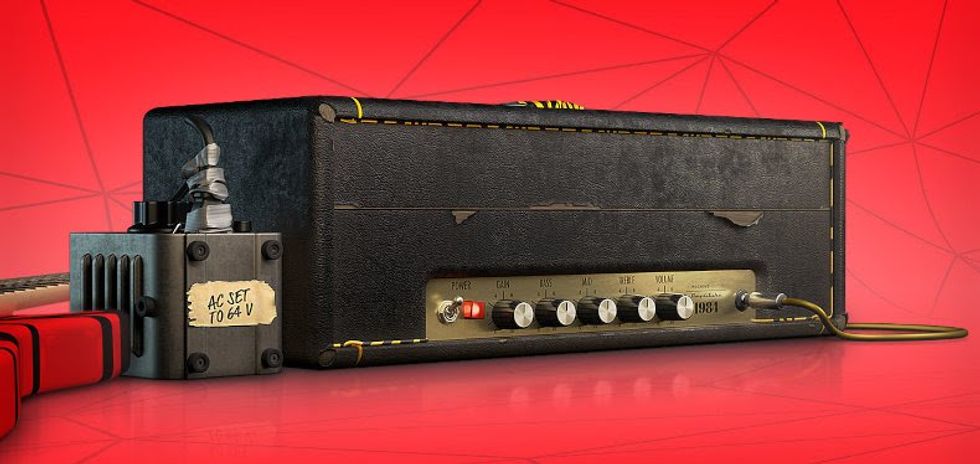
1982 Tone Models
The '82 sessions introduced a brighter, more layered tone while preserving the core character of the previous recordings. The G12-65 speaker remained key to the sound, delivering a tight low end, warm midrange, and a smoother, less spiky high end than the earlier Greenbacks. Recorded in Amigo studios, changes in mic placement and outboard gear added polish and dimension, resulting in a more refined studio sound.
1984 Tone Models
The '84 sessions marked a leap forward in tonal precision and production quality. Tracked and mixed at a newly built studio in Coldwater Canyon, the sound became more controlled and processed, yet still retained the grit and energy of earlier recordings. The suspected use of Telefunken EL34s likely contributed to the added warmth and mid-forward presence, while amp tweaks and precise Variac adjustments gave each track its own tonal identity.
The Amp: "The ONE"
At the heart of the Brown Sound 82/84 collection is "The ONE" - a meticulously crafted Marshall-style amp built from the ground up with the exact same spec as the infamous 1968 Super Lead serial number #12301, including crucial mods that capture the DNA of the early brown sound like no other amp model.
No Tone Unturned
Each Tone Model was built using controllable levers like Variac voltage, cab voicing, mic geometry, and parallel load, with options spanning different voltages, speakers, and pickups to reflect the shift from '82 to '84. All models are level-matched, offered with or without parallel load, and captured raw without post-processing for authentic, period-correct amp tones.
Ready to Play
As with all collections in the series, these Tone Models were crafted using period-correct gear and capture techniques to recreate the final two albums of that era genuinely. Each Tone Model reproduces the recorded album tone in exquisite detail, offering an ideal foundation for adding time-based effects—either within TONEX or through a favorite pedal.
Pricing and Availability
The Brown Sound 82/84 Signature Collection is now available via ToneNET and within any version of TONEX for Mac/PC at $/€99.99.*
- TONEX Brown Sound 78/79 - $/€99.99* - Includes 50 Tone Models.
- TONEX Brown Sound 80/81 - $/€99.99 - Includes 73 Tone Models.
- TONEX Brown Sound 82/84 - $/€99.99 - Includes 83 Tone Models.
- TONEX ONE Brown Sound Limited Edition - $/€249.99 - Available in white, red, or yellow. Includes Brown Sound 78/79 and a choice of one other Brown Sound collection (a $/€199.98 software value). Existing Brown Sound 78/79 users will receive a $/€50 discount at the IK store.
- TONEX Brown Sound Anthology Collector's Limited Edition - $/€599.99 - Shipping now. Box set includes all three colors of TONEX ONE (white, red, and yellow) plus all three Brown Sound Signature Collections (78/79, 80/81, and 82/84). Limited to 200 units worldwide.
*Pricing excluding taxes.
For complete details and information about the Brown Sound Anthology collections and pedals, and to hear the tones, visit:
Find Your Voice
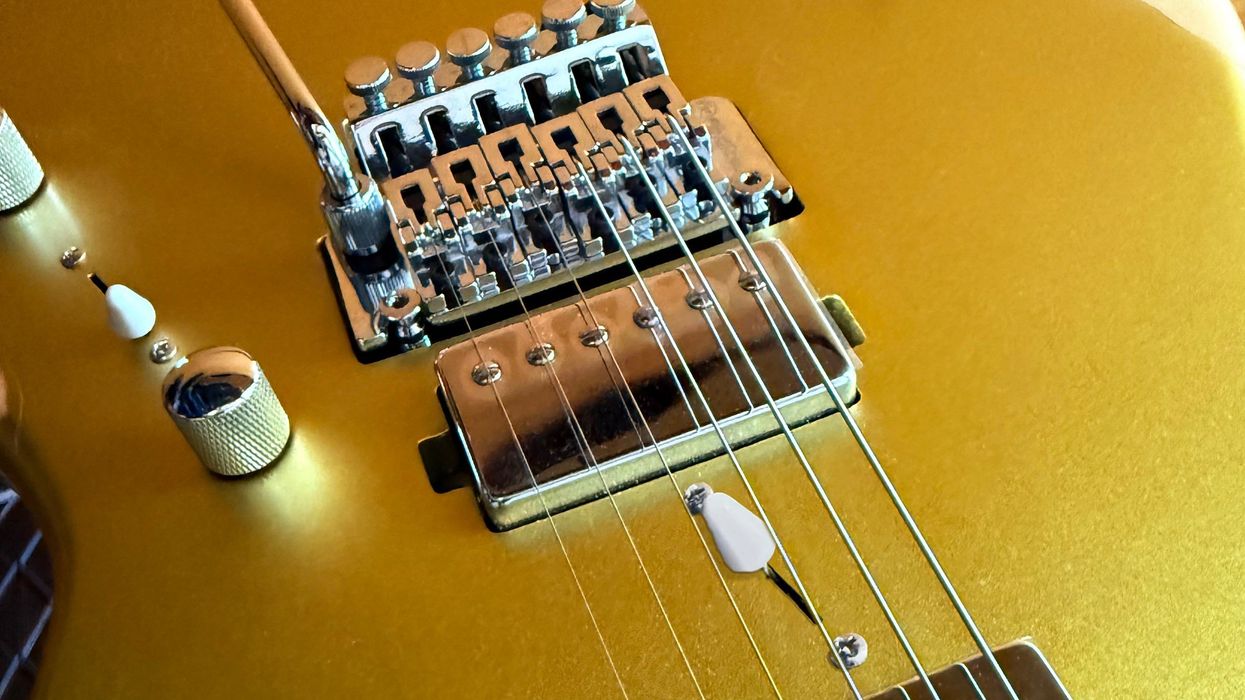
Over the years I’ve often been asked for advice about how to “get into the business” of either the playing or building of guitars. Despite my reluctance to toss anyone into the hellhole pit that is either of these two endeavors, I do my best to help. That isn’t to imply that building guitars or playing music isn’t satisfying—it most certainly can be. In fact, many of us have built fulfilling and profitable careers in both of these trades, not to mention made lifelong friends. What are you hoping for? Is this going to be your job, with hopes that it won’t seem like drudgery? Do you just like to mess around with gear and wonder what it would be like to do it for pay? Like almost everything in life, it’s the managing of expectations that’s at the heart of the matter.
If it’s money you’re after, there are people more qualified to guide you than me. Yes, I’ve managed to scrape together a living while seemingly avoiding the grind of a “normal” job, but it hasn’t been a cake walk. I’d be afraid to add up the hours I’ve spent doing things I would have rather not had to do. I call it the 80/20 rule. You spend 80 percent of your time doing stuff you’d rather not do, and 20 percent doing the things you love—and I’m being generous here. If that seems like a normal job to you, you’d probably be correct. But despite all of that, let’s talk about how to get started anyway.
If you want to follow your muse and cut your own path, approach things like an artist who dropped out of business school. Be prepared to use your truncated education on 80 percent of the work, and let your freak flag fly on the 20 percent that makes you be you. Not everything you create will solve problems and answer questions for your customers and fans, but that’s not the point—at least in the creative part. Don’t worry, your rational self will be waiting down the line to reveal the cold hard truth later.
“Being a creative person is a series of trial-and-error episodes as much as any kind of formal schooling.”
In art critic Jerry Saltz’s book How to Be an Artist, he spells out how to discover your path—a sort of step-by-step guide to making the right kind of “mistakes” that bring you to the place where you know and understand how to be uniquely you. In fact, you might want to stop reading my drivel and go buy his book now. That gets us both off the hook.
Saltz’s process seems very familiar to me. You see, being a creative person is a series of trial-and-error episodes as much as any kind of formal schooling. It’s good to learn the history of your craft—all of it. Learn the way artists look at the world. Try to imagine how the constraints of what has come before benefit and hold us back. You can’t break the rules unless you know them and why they exist. There are conventions that should be questioned, and others that are the bedrock of the game you are playing. Learn how to tell the difference.
Maybe you’ve heard that there are only seven basic story arcs: overcoming the monster, rags to riches, the quest, voyage and return, comedy, tragedy, and rebirth. But we all know that within these themes there are infinite possibilities. That’s your ticket. That’s where your personality and character carve out your unique vision. I like to think of guitars (and songs) as story arcs. There may be only a few archetypes, and almost everyone follows them, but what’s important is the way you tell the story. On a guitar, you shouldn’t just decide to put a toggle switch in the middle of the fretboard because you want to be different, but you can decide to make that switch do something that hasn’t been done. I usually stop at that point and ask the 80 percent dude in me if this will actually help anyone, although I am free to ignore the answer if it helps to tell the story I am telling.
In the end, if you pay attention to what you like, the story you are telling will be a reflection of you. When that story makes sense to your audience, too, you’re in business. And that’s how you make a life as an artist
System of a Down's Daron Malakian Rig Rundown
The metal giants return to the stage with a show powered by gold-and-black axes and pure tube power.
Except for two new singles in 2020, alt-metal icons System of a Down haven’t released new music in 20 years. But luckily for their fans, System—vocalist Serj Tankian, guitarist/vocalist Daron Malakian, bassist Shavo Odadjian, and drummer John Dolmayan—took their catalog of era-defining, genre-changing hard-rock haymakers on tour this year across South and North America.
PG’s Chris Kies connected with Malakian onstage at Soldier Field in Chicago ahead of System’s second show at the football stadium. Malakian and his tech, Patrick Lachman, explained how some color-coded Gibson, Ibanez, and Friedman gear give Malakian the fire he needs to burn through the band’s legendary set.
Brought to you by D’Addario.
SG With SDs
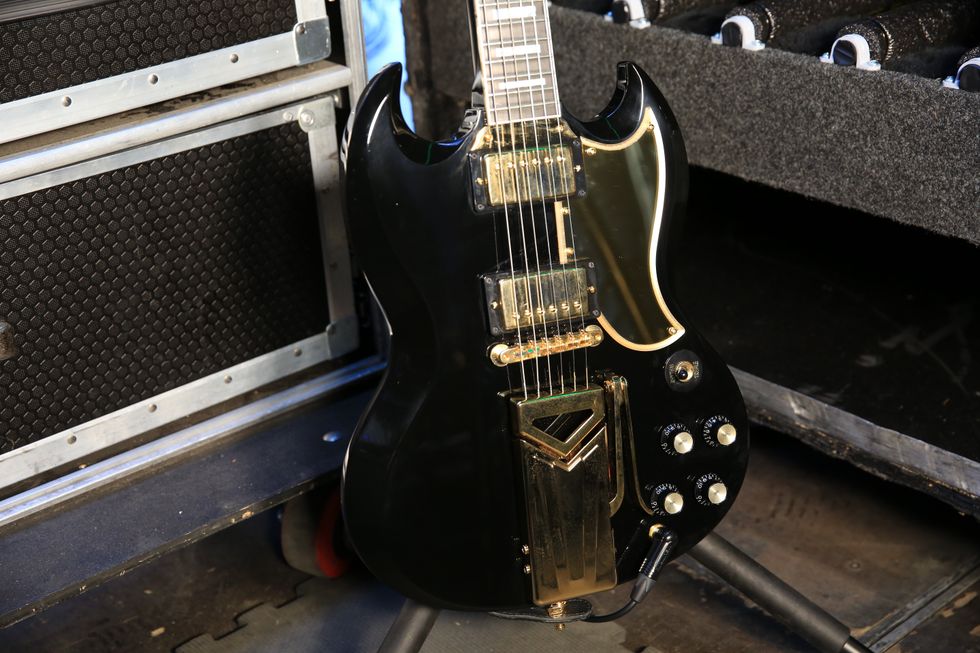
This Gibson SG is brand new and “hot off the presses,” per Malakian’s tech, Lachman. Built in Gibson’s Custom Shop, it’s got Seymour Duncan Custom Shop pickups. On this run, he starts shows on this guitar, and will typically switch things up after about 10 songs.
Malakian plays custom, extra-pointy Dunlop picks, and runs all his axes with a custom set of Ernie Ball strings (.010–0.50). System’s catalog, and therefore Malakian’s guitars, are predominantly in drop-C tuning.
Freeze!
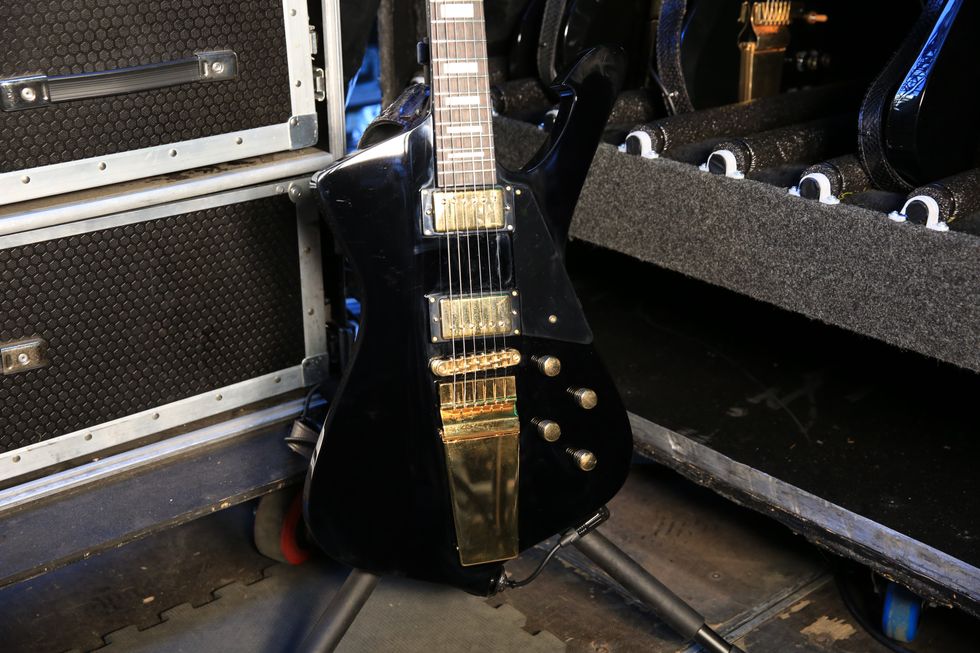
Next up during the set, Malakian will turn to his iconic Ibanez Iceman, one of his most heavily leaned-upon toys during this tour. This one has black “secret ninja binding,” his tech quips, virtually invisible to all but Malakian. It’s wired with Seymour Duncan Custom Shop Pearly Gates pickups.
B.Y.O.V.
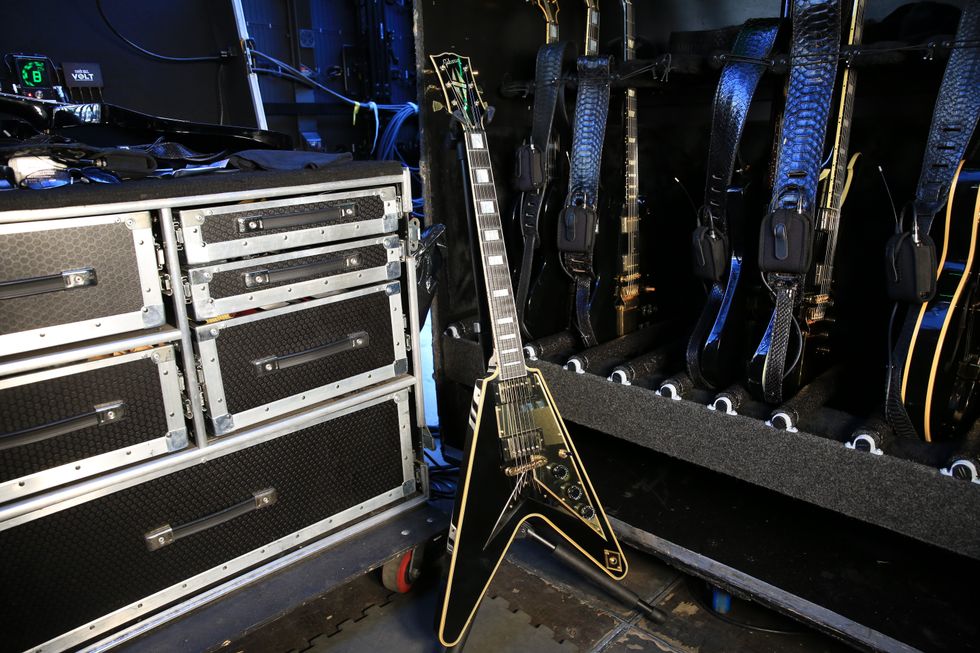
Malakian always liked how Albert King’s Flying V looked with its Les Paul-style headstock, so when Gibson was making him a V, he requested that it be outfitted with the same look. This one’s rocking a pair of Seymour Duncan Saturday Night Special pickups.
Semi-Hollow Star
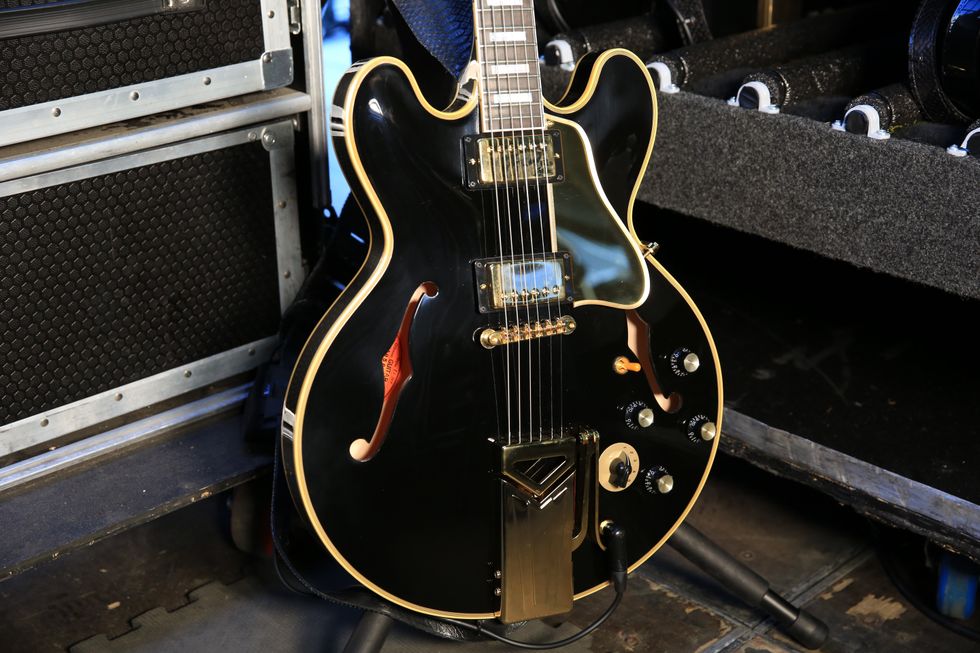
This Gibson ES-335, dressed in the same black-and-gold scheme as all of Malakian’s guitars, also came fresh from the Custom Shop for this run of shows.
Old and New, All Tube
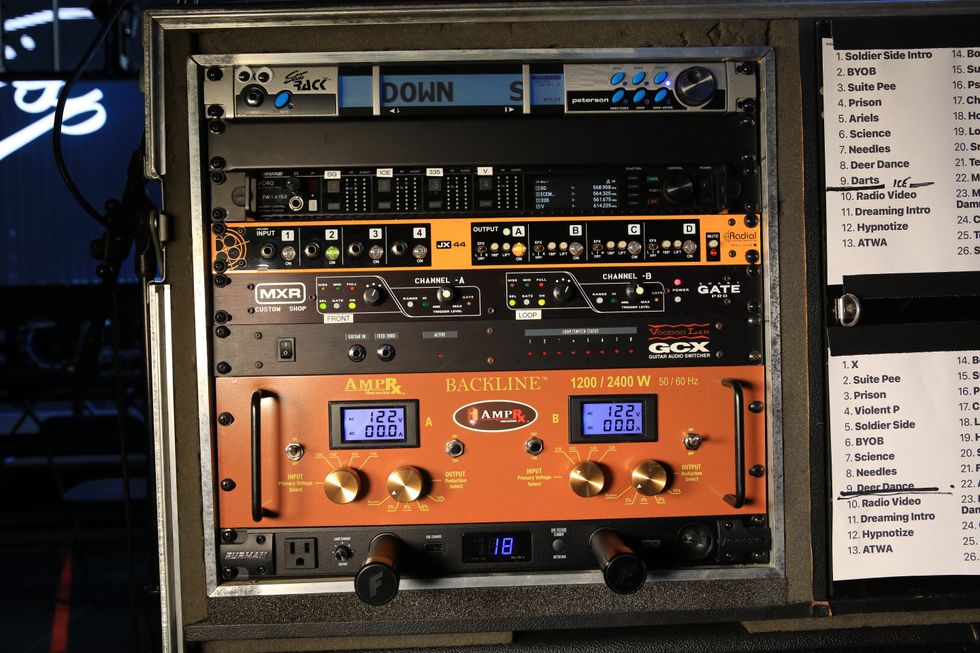
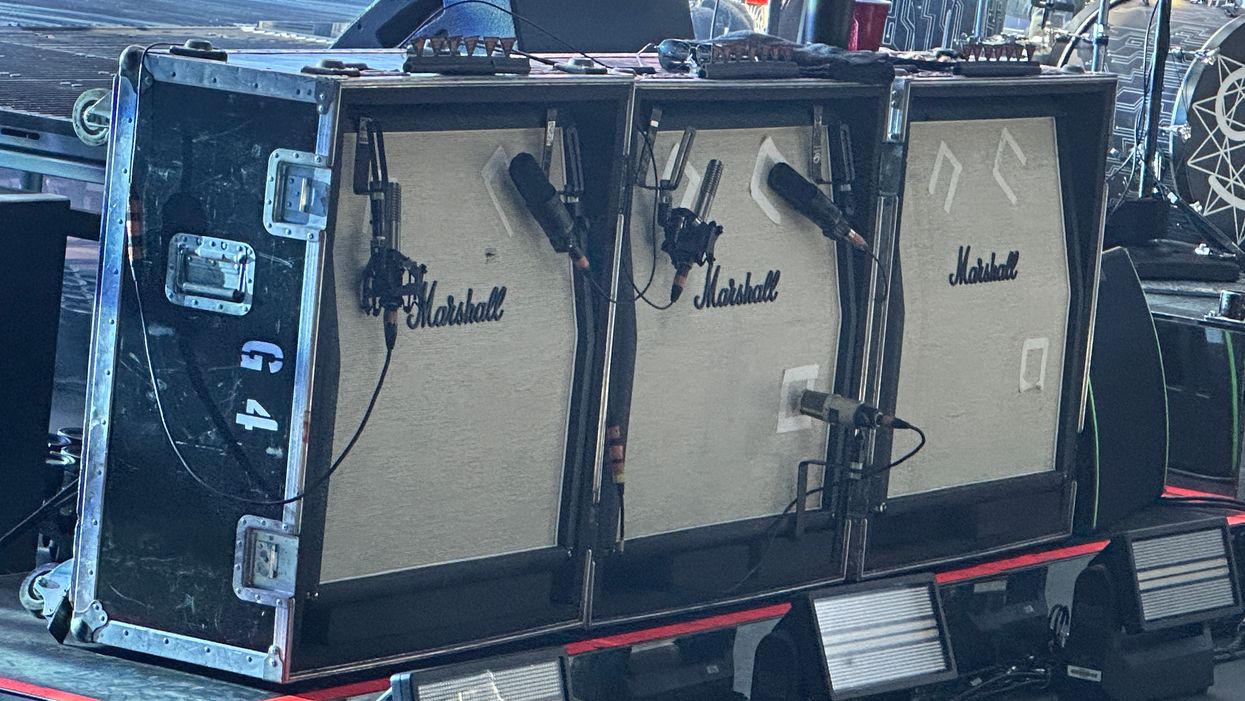
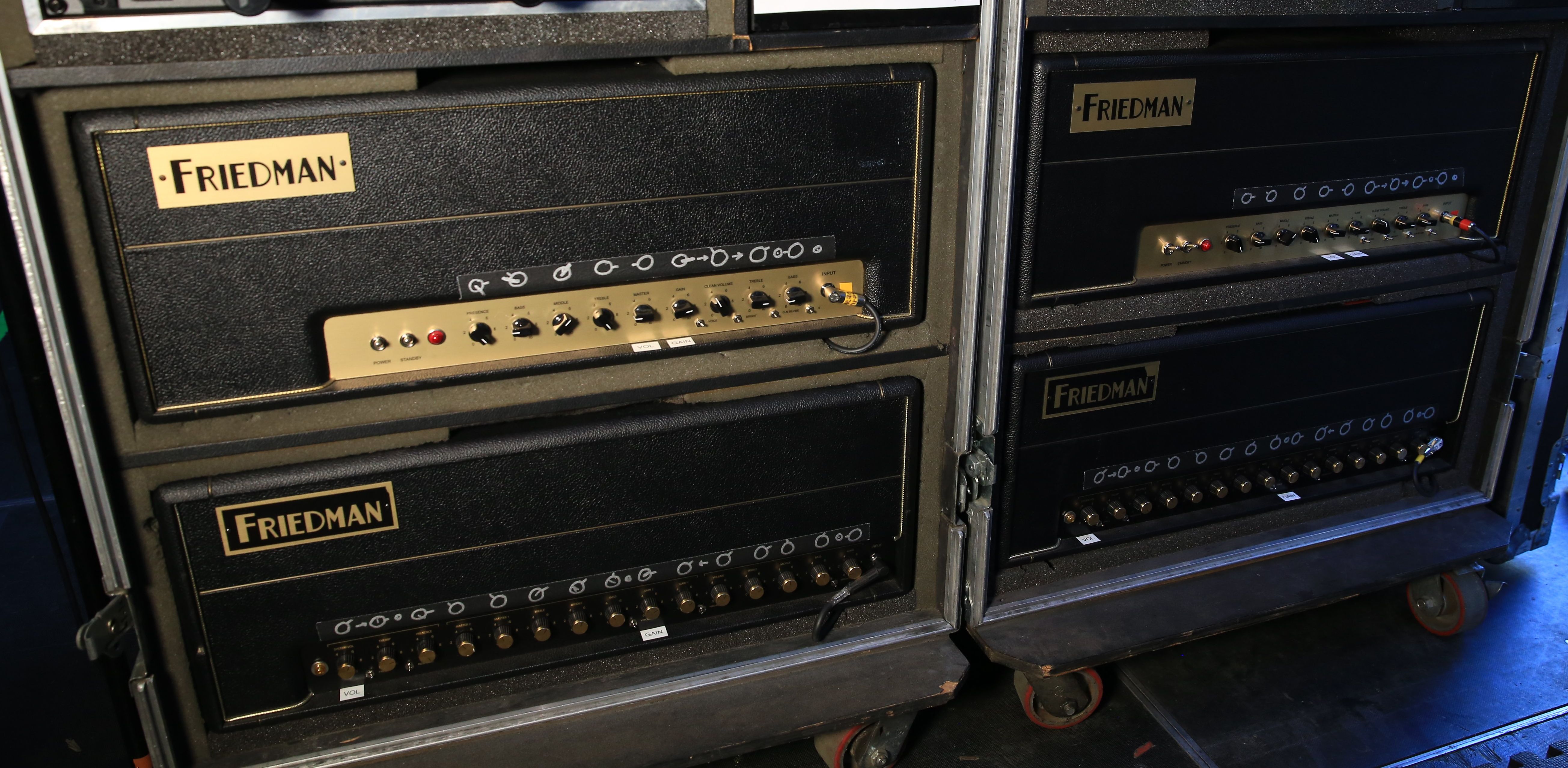
Malakian doesn’t have anything against modeling technology, but he prefers to keep things old-school. He runs two generations of Friedman BE-100 heads at the same time: The newer BE-100 Deluxe head (below) is used for dirty tones, while the first-gen BE-100 (above) stays dialed for cleans. They’re connected to two Marshall 4x12 cabinets onstage, dedicated to either the clean or overdriven signals. The speakers are Celestion G12M-70s.
Loaded onto Malakian’s rack above the amp heads are a Shure AD4Q, Radial JX 44, MXR Smart Gate Pro, Voodoo Lab GCX, AmpRx Backline, and Furman PL-Pro DMC.
Daron Malakian’s Pedalboard
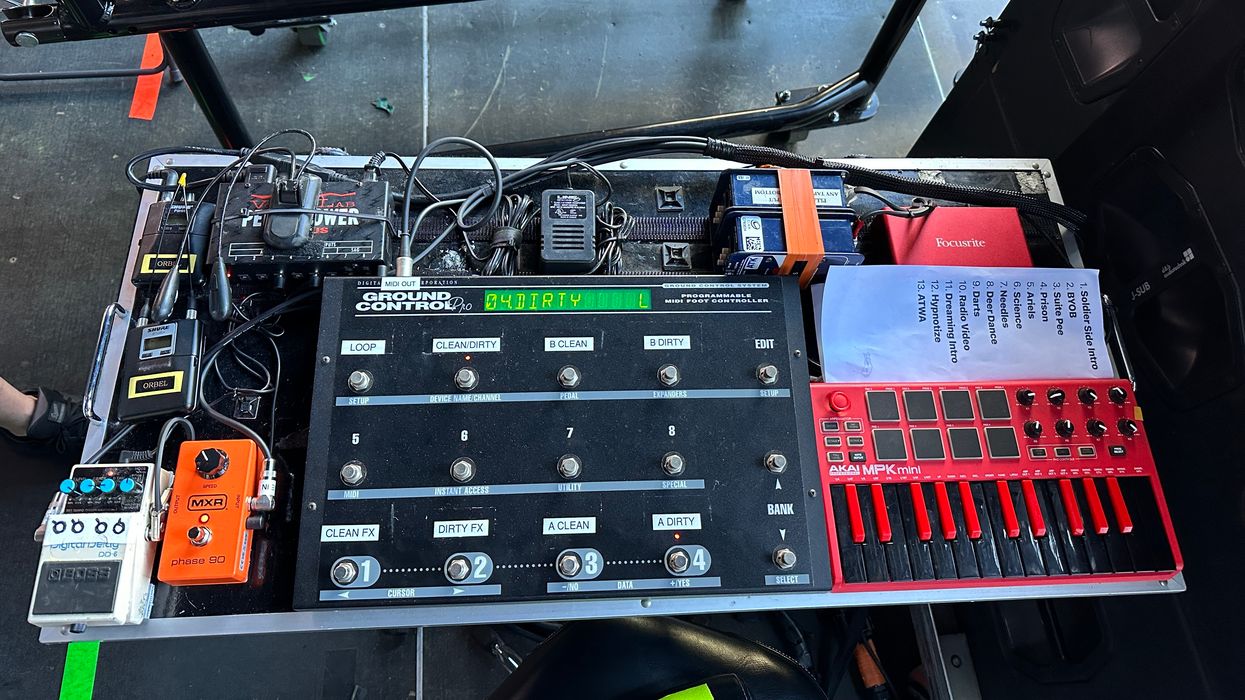
Malakian’s switching is handled backstage by his Scars on Broadway bandmate Orbel Babayan via this board. In addition to a Voodoo Lab Ground Control Pro switcher, Akai MPK Mini, and Scarlett Focusrite interface, the board is dead simple, with just an MXR Phase 90 and Boss DD-6 delay. No dirt pedals needed; all Malakian’s drive comes from the Friedman. A Voodoo Lab Pedal Power 2 Plus fires up the affair.

Ernie Ball Custom Set (.010-0.50)
Peter Frampton & Warren Haynes: 'The Art Of Music' Debuts Sept 6 on Public TV

Rock & Roll Hall of Fame inductee, GRAMMY® Award-winning musician and one of the most celebrated artists in rock history, Peter Frampton, is the latest artist featured in the new public television series The Art of Music premiering September 6, 2025. Presented by United MileagePlus® Cards from Chase and filmed in front of a live invited audience at The Metropolitan Museum of Art in New York City, Frampton is interviewed by guitarist, singer and songwriter Warren Haynes.
As part of this unique series, Haynes led a conversation with Frampton about his musical journey, sharing insights into his creative processes. The discussion intertwined some of Frampton’s timeless hits such as “Do You Feel Like We Do”, “Baby I Love Your Way”, and “Show Me The Way”.
“It was wonderful performing for The Art of Music series, it’s such a unique way of putting art and music together and to have done this at The Met, what an honor,” says Frampton.
The Art of Music, created and executive produced by iMaggination’s Don Maggi, was created to give viewers a rare look inside the artists’ lives and their creative practice at the prestigious Metropolitan Museum of Art. In this episode, after nearly 50 years since Frampton Comes Alive! was released, which remains one of the top-selling live records of all time–selling over 17 million worldwide, the celebrated guitarist shares stories about his vast catalog and significant moments in his career.
“We're excited to share this new episode of The Art of Music featuring Peter Frampton and Warren Haynes,” says Maggi. “The combination of these two legends together on stage within the walls of the prestigious Metropolitan Museum of Art offers audiences a unique and intimate look inside Frampton's historic journey through storytelling and performance.”
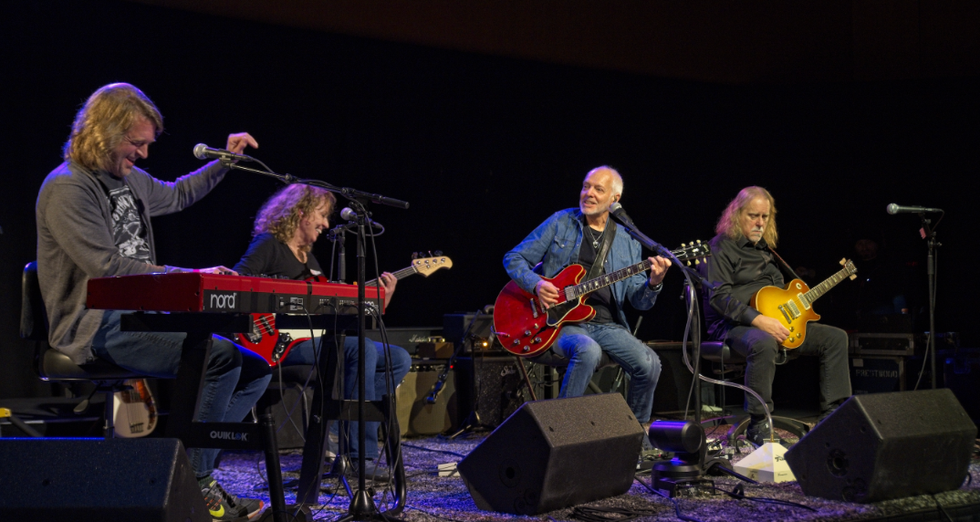
“We were thrilled to welcome Peter Frampton to The Met for an unforgettable visit. Sharing our newly acquired collection of American guitars with him was a true privilege, made all the more special as Frampton recounted his journey as a guitarist and performed some of his most iconic music." - Jayson Kerr Dobney, Frederick P. Rose Curator in Charge of the Department of Musical Instruments at The Met
Frampton’s episode of The Art of Music will air on public television stations nationwide beginning September 6, 2025. Fans may also watch on The Art of Music website or stream on the PBS app.
The national public television World Channel will air the episode Saturday, October 4 at 7pm ET, with a repeat on Monday October 6 at 5am ET (adjust by time zone). Visit worldchannel.org to find your local World Channel station. The program will air on the
All Arts Channel and on the All Arts app in the New York Metro area on Saturday, October 25 at 9 pm.
This special interview and performance featuring Peter Frampton presented by United MileagePlus® Cards from Chase was an unforgettable occasion for Chase United Cardmembers who were invited to attend the intimate live taping. The United MileagePlus® Cards from Chase provide Cardmembers with access to exclusive events and experiences in addition to many reward and travel benefits with United Airlines. Underwriters for The Art of Music are The Mark Hotel and SUNDRAGON.
Additional artists to be announced for the series soon. For more information, visit https://theartofmusic.org.
PRS Guitars Brings Back the Mira as an S2 594
PRS Guitars today announced the return of the Mira model to the Maryland factory line, now with the 24.594” scale length. This new iteration, available in both gloss and satin finishes, will be a regular offering in the S2 Series.
The 22-fret S2 Mira 594 covers a wide range of styles, including rock, blues, garage, and punk. Pairing its all-mahogany construction with PRS 58/15 LT vintage-voiced pickups results in warm, focused midrange. The humbuckers are paired with two mini-toggle switches to individually tap the pickups, delivering both authentic humbucking and chimey single-coil sounds.
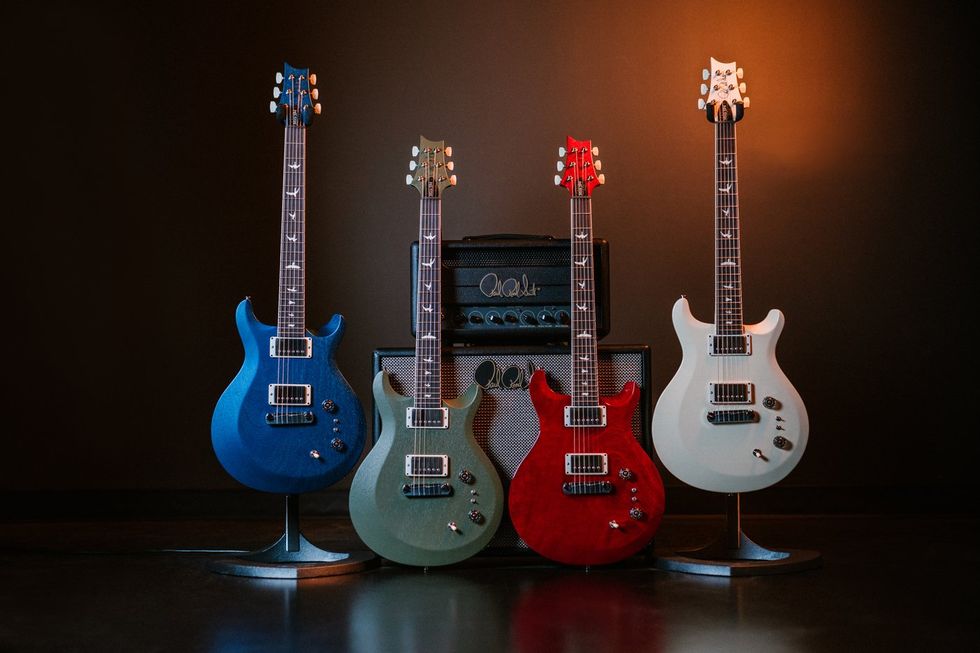
“The Mira has had an interesting history over the course of the last 17 years, but I don’t think it found its true voice until now,” said PRS Guitars Director of Sales, Jim Cullen. “The S2 Mira 594 combines our 24.594” scale length with a Pattern Thin neck shape and a very simple and straight forward feature set that provides an incredibly lively, simple-to-use tool to create music. I hope you are as inspired as we are with the newest evolution of this classic model.”
The S2 Mira 594 is available in: Antique White, Black, Dark Cherry Sunburst, Platinum Metallic, Vintage Cherry, and debut color Black Rainbow Holoflake.
The S2 Mira 594 Satin features the PRS “sinky” satin nitro finish, and is available in: Matcha Green, Mavis Mint Metallic, Metallic Midnight, Dark Cherry Sunburst, Red Apple Metallic, and debut color Cloud Burst.
The Mira was first introduced in 2007 as an all-mahogany pickguard guitar with moon inlays, 24 frets, 25" scale length, a stoptail bridge, and a single mini-toggle. It has appeared across all of the Series and in various configurations, including the popular Mira X. In 2013, the Mira was moved from Core and was one of three models to launch the S2 Series. It was last offered as an S2 in 2018, becoming part of the SE Series from 2020-2023.
PRS Guitars continues its schedule of launching new products each month in 2025. Stay tuned to see new gear and 40th Anniversary limited-edition guitars throughout the year. For all of the latest news, click www.prsguitars.com/40 and follow @prsguitars on Instagram, Tik Tok, Facebook, X, and YouTube.
PRS Guitars Brings Back the Mira as an S2 594
PRS Guitars today announced the return of the Mira model to the Maryland factory line, now with the 24.594” scale length. This new iteration, available in both gloss and satin finishes, will be a regular offering in the S2 Series.
The 22-fret S2 Mira 594 covers a wide range of styles, including rock, blues, garage, and punk. Pairing its all-mahogany construction with PRS 58/15 LT vintage-voiced pickups results in warm, focused midrange. The humbuckers are paired with two mini-toggle switches to individually tap the pickups, delivering both authentic humbucking and chimey single-coil sounds.

“The Mira has had an interesting history over the course of the last 17 years, but I don’t think it found its true voice until now,” said PRS Guitars Director of Sales, Jim Cullen. “The S2 Mira 594 combines our 24.594” scale length with a Pattern Thin neck shape and a very simple and straight forward feature set that provides an incredibly lively, simple-to-use tool to create music. I hope you are as inspired as we are with the newest evolution of this classic model.”
The S2 Mira 594 is available in: Antique White, Black, Dark Cherry Sunburst, Platinum Metallic, Vintage Cherry, and debut color Black Rainbow Holoflake.
The S2 Mira 594 Satin features the PRS “sinky” satin nitro finish, and is available in: Matcha Green, Mavis Mint Metallic, Metallic Midnight, Dark Cherry Sunburst, Red Apple Metallic, and debut color Cloud Burst.
The Mira was first introduced in 2007 as an all-mahogany pickguard guitar with moon inlays, 24 frets, 25" scale length, a stoptail bridge, and a single mini-toggle. It has appeared across all of the Series and in various configurations, including the popular Mira X. In 2013, the Mira was moved from Core and was one of three models to launch the S2 Series. It was last offered as an S2 in 2018, becoming part of the SE Series from 2020-2023.
PRS Guitars continues its schedule of launching new products each month in 2025. Stay tuned to see new gear and 40th Anniversary limited-edition guitars throughout the year. For all of the latest news, click www.prsguitars.com/40 and follow @prsguitars on Instagram, Tik Tok, Facebook, X, and YouTube.
Question of the Month: The Pedals of Our Dreams
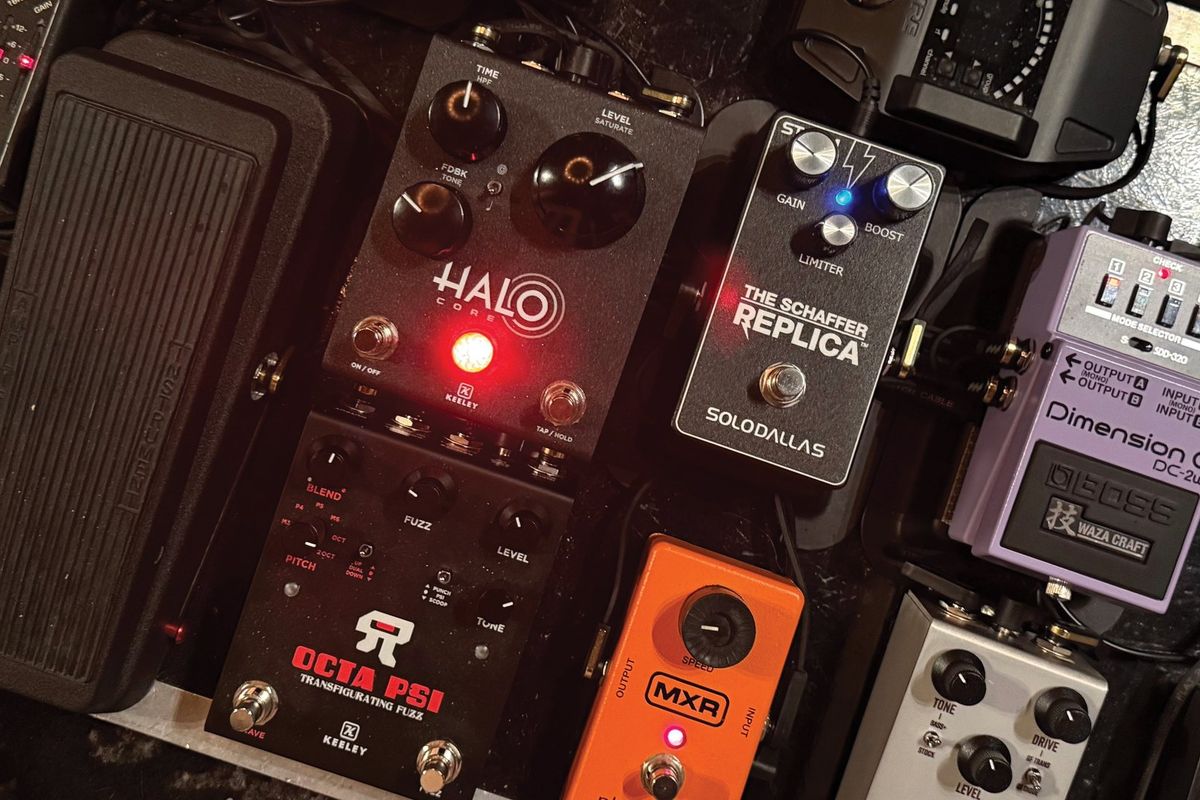
Question: What pedal doesn't exist now that you hope gets built in the next year?
Guest Picker - Penelope StevensMotherhood, Penny & the Pits
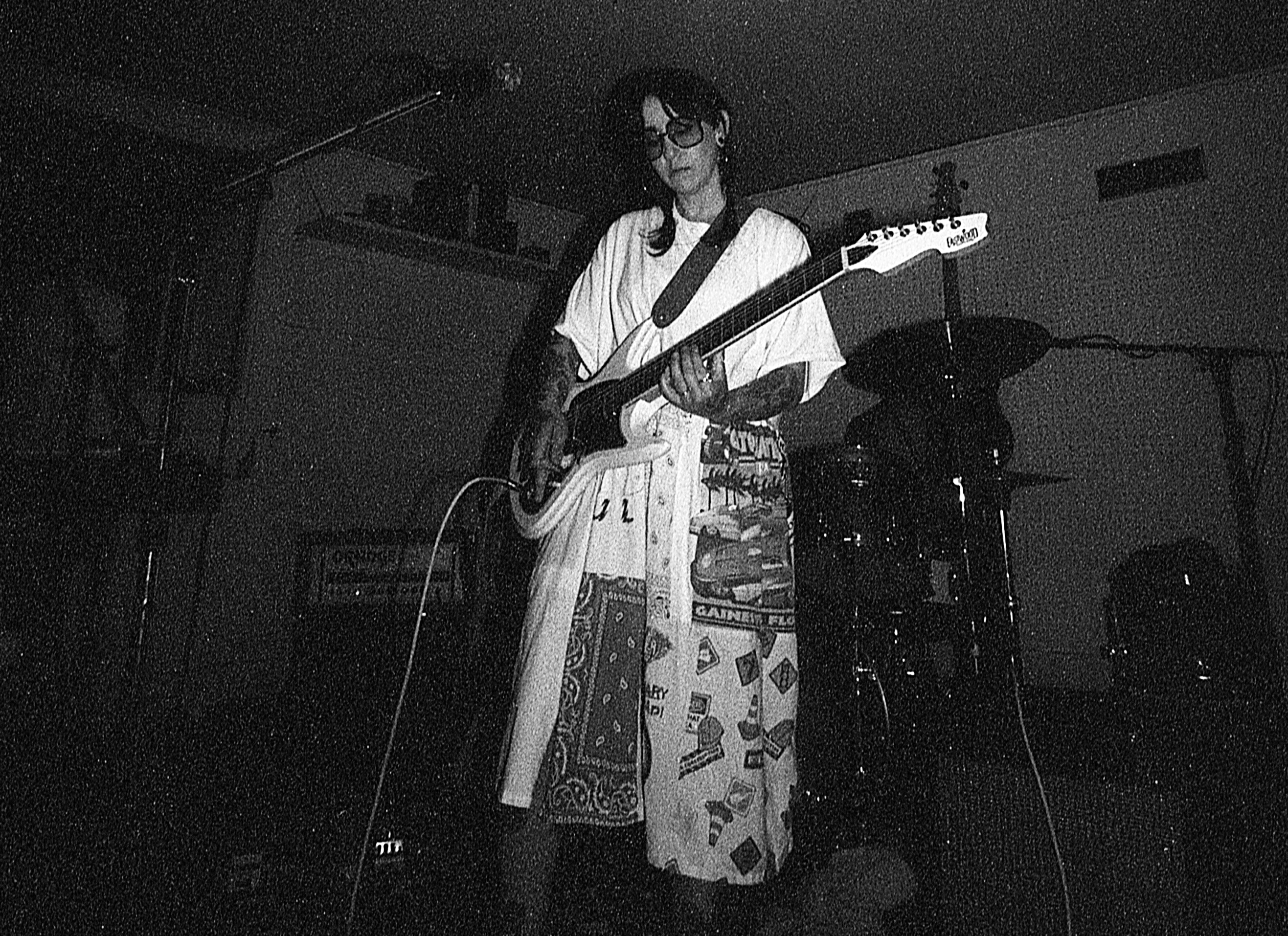
A: I’m a synth player before a guitarist, and for years I’ve been trying to figure out a way to play my synths through my guitar … or my guitar through my synths? I know there are pedals that can make your guitar sound like a synth, even some that can emulate particular models, but I want a pedal that I can connect to any synth, and it can feed whatever patch I’ve built through my chain. I have a Volca Keys that makes absolutely GNARLY tones, and for a while I was trying to figure out a way to have it in my pedalboard as an effect. Alas, this is quite beyond my skillset—I’m no electrical engineer—but the dream has never died. Imagine being able to shape your guitar tone with as many possibilities as on an analog synth! Can somebody make me this pedal please?
Obsession: When I’m not touring, I’m a cocktail bartender. (PLEASE don’t call me a mixologist.) My current obsession is this margarita riff I’ve been working on: tequila blanco, amaretto, lime, and prickly pear shrub. I’m drinking this little number more than I should probably admit, especially as we fight a heat wave in eastern Canada. I’ve been making cocktails to go along with each song on my new album, and filming tutorials for each one on Instagram. The prickly pear margarita will be making an appearance soon!
Reader of the Month - Jin J. X
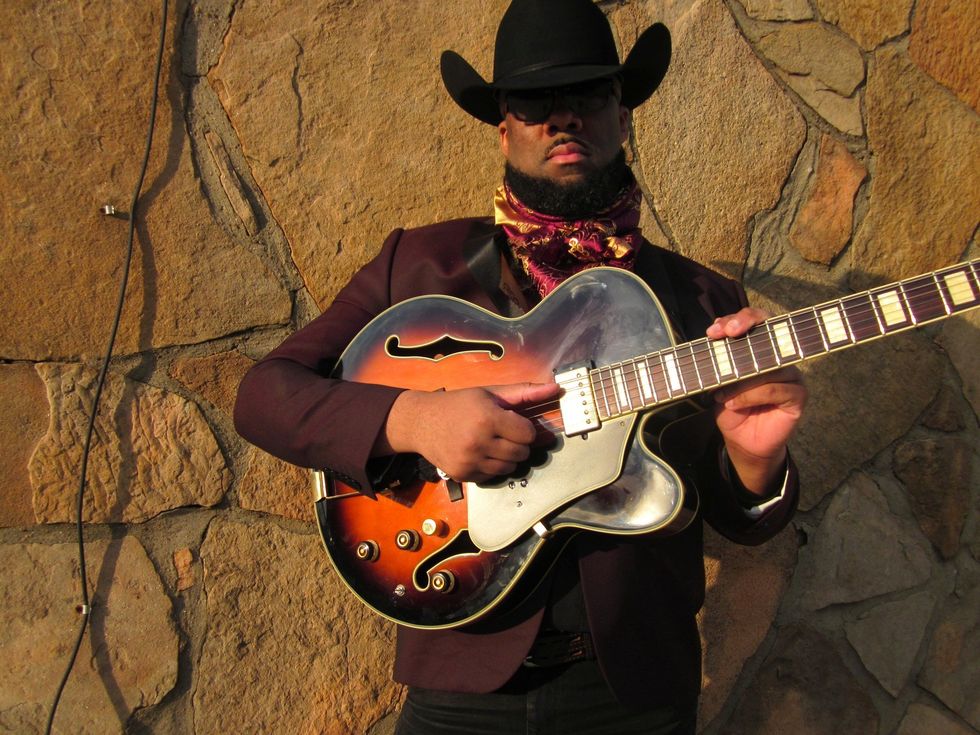
A: The out-of-production Boss VB-2. I absolutely love chorus and vibrato. I also love Boss. While I appreciate the CE-2w and absolutely love the upgrade/update, I just haven’t been able to connect with its counterpart, the VB-2w. I’ve tried multiple times to buy that pedal but to no avail. The Behringer UV-300 is analog and sounds absolutely perfect, though I’ve found that every single one I’ve bought over the years has a switch failure, and many modders can’t really work with them. Also, there are other great vibrato pedals, though without the “rise” function of the VB-2, I don’t find them as useful. I’ve heard the BYOC folks make one, though they seem to sell very quickly. I hope Boss, or someone, makes a true-blue VB-2-style pedal, with the right analog chip, that is built with solid components.
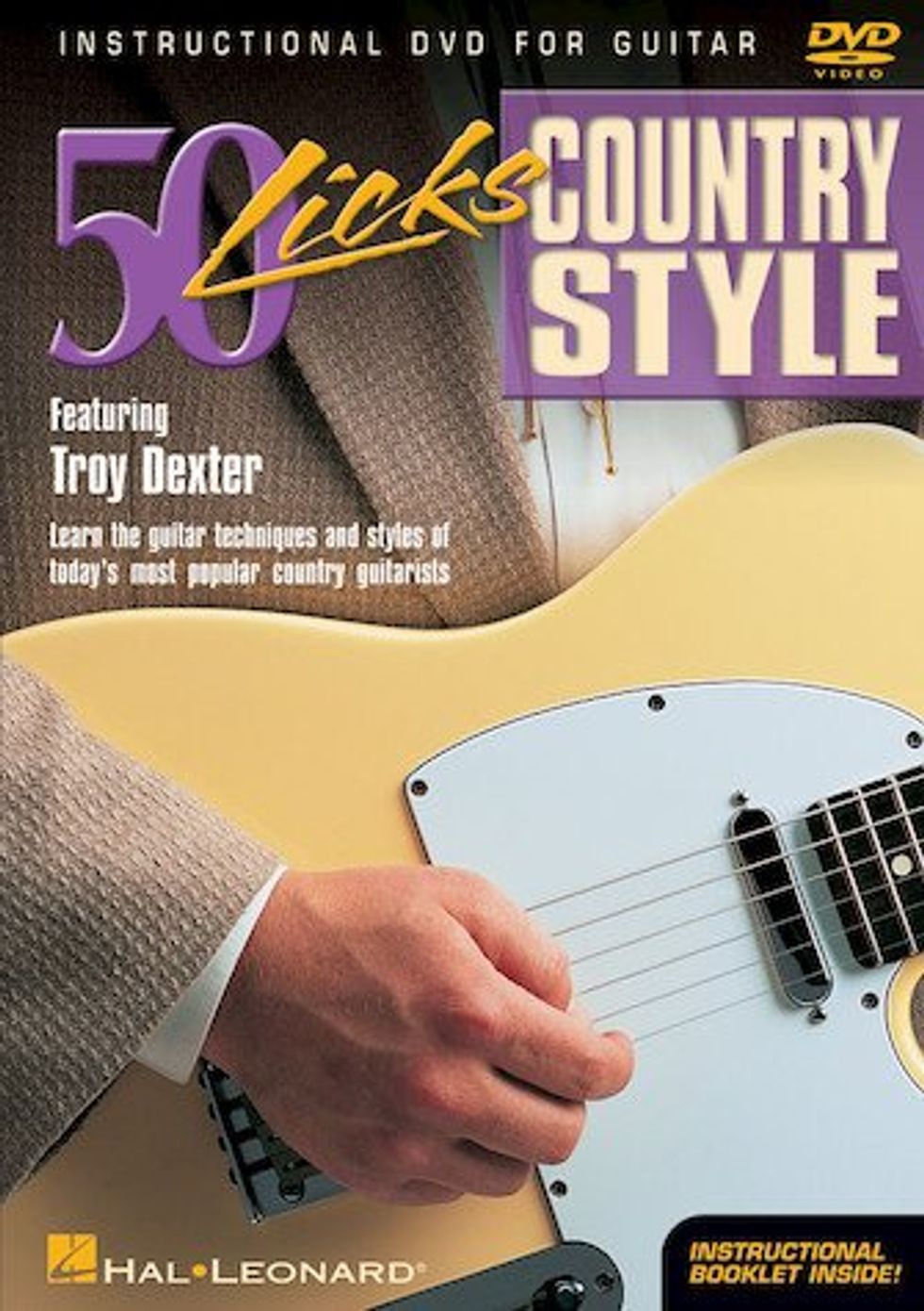
Obsession: Country-style guitar. Fifteen years ago, I bought a DVD called 50 Licks Country Style featuring Troy Dexter. After all these years, I finally pulled it out of the plastic and have begun trying to work those up. In many ways, the licks revolve around dominant 7 chords, so, in some ways, these country licks sound like jazz licks in the bridge position. It’s like a two-for-one special learning them. I also recently released an Afro-futurist/country album earlier this year called The Barefoot, Pregnant, Neck Beard, Marital Bed String Band, so I’ve been playing and promoting that record and putting my country licks to good use.
Brett Petrusek - Director of Advertising

A: I’d love a Boss Waza Craft Dimension C with a mix control knob, or better yet a Waza Craft reissue of the Digital Dimension with expanded tonal range, better filtering, fancy high-quality buffer, and with that ultra-low noise floor.
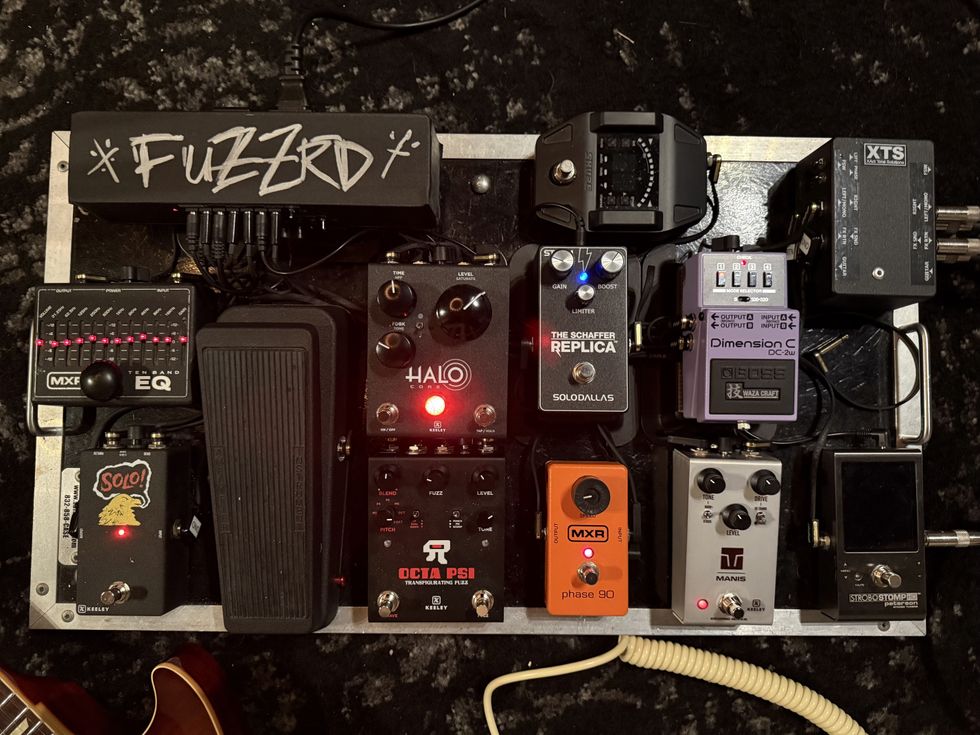
Obsession: Auditioning stereo modulation pedals. I use pedals like this in my live rig to split out in front of two big amps to expand the stereo field. I like the option of being able to keep it subtle and having easy access right on my pedalboard (old-school). It’s an art form to find modulation or doubler pedals that will do this into the front end of high-gain amps without a lot of hiss. I am currently digging the Mr. Black DoubleTracker Stereo; it can get insanely wide (especially in the effects loop). Maybe Keeley will make a stereo 30 ms in their new folded aluminum enclosures … I bet their fanbase would go nuts!
Nick Millevoi - Senior Editor
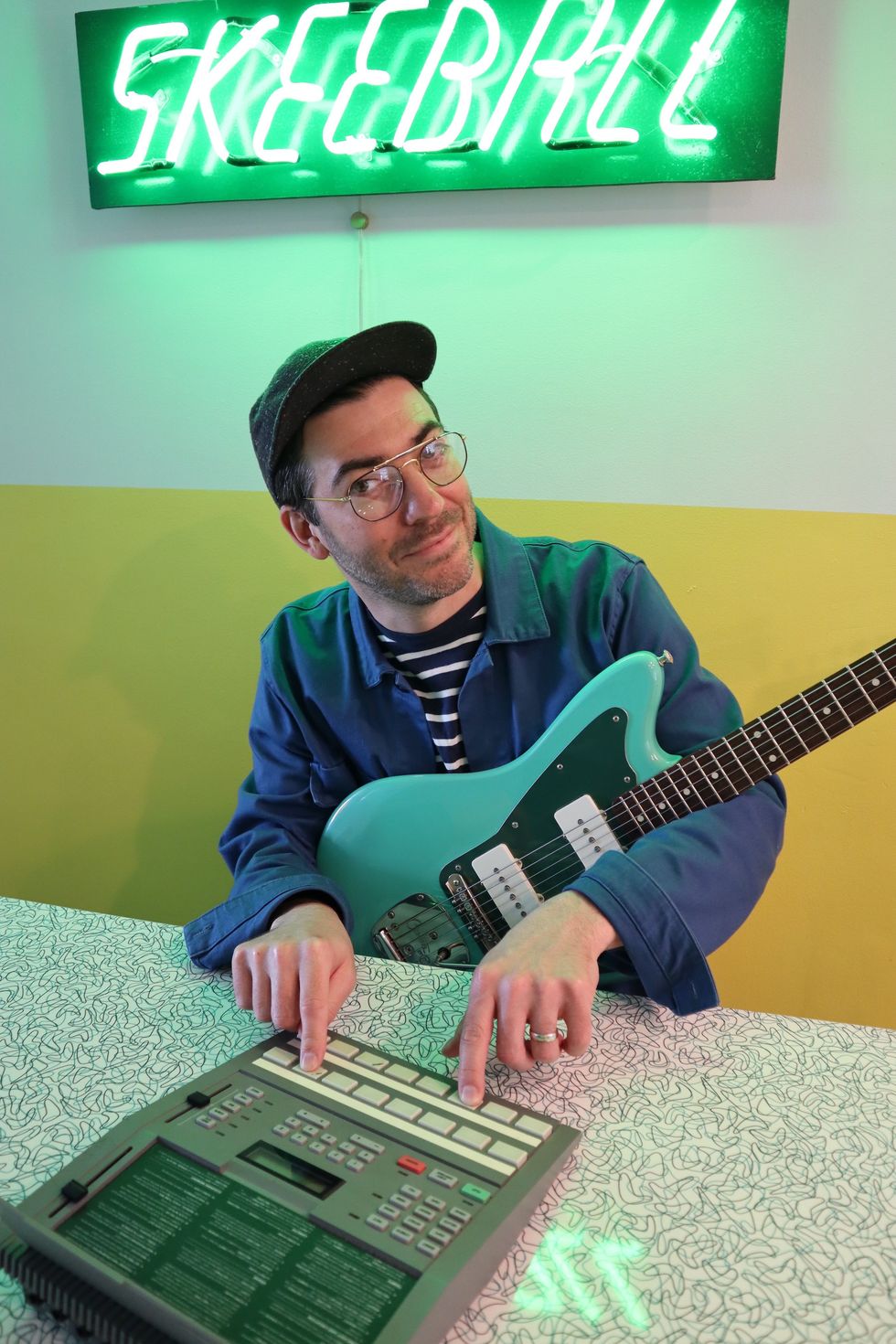
A: I’ve spent years longing for a pedal that captures the unique sonic capabilities of the Lexicon Prime Time. The Soundtoys PrimalTap plugin does an excellent job for working at home, but I dream of making those warm, ethereal sounds live (and the pricey rack unit itself isn’t practical for most of us). The Prime Time’s double delay lines with lo-fi-enhancing multiply knob sounds truly unique among delay units (dig it, Daniel Lanois enthusiasts), and its hip primary color knobs demand pedalboard real estate!
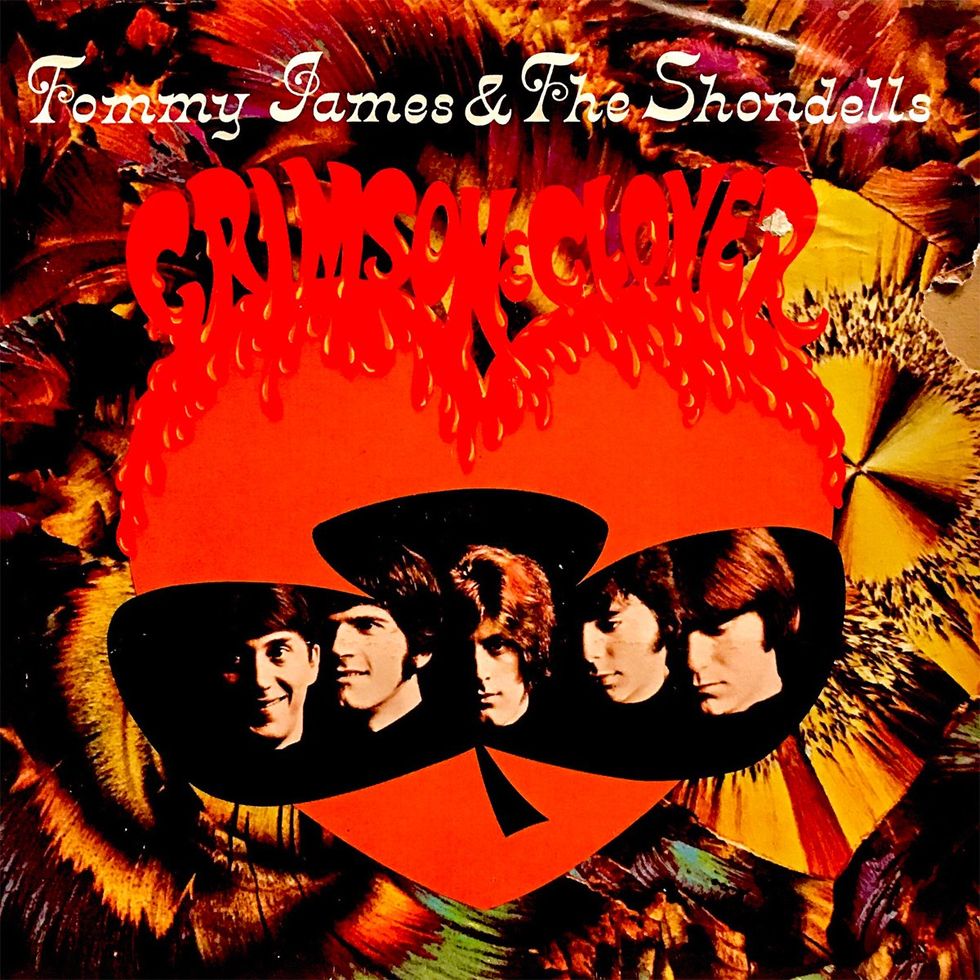
Obsession: I just caught Tommy James & the Shondells live and was blown away. Over the course of a relentlessly hit-laden set list—seriously, it was one after another: “Crystal Blue Persuasion,” “Mony Mony,” “Crimson and Clover,” “I Think We’re Alone Now,” “Draggin’ the Line,” and on and on—Tommy’s voice was in the finest form, driven by a powerful, heavy-grooving band. Go see ’em if you can!
T-Rex Effects Twin Blaze Giveaway from Guitars.net!

T-Rex Twin Blaze Giveaway from Guitars.net
T-Rex Twin Blaze
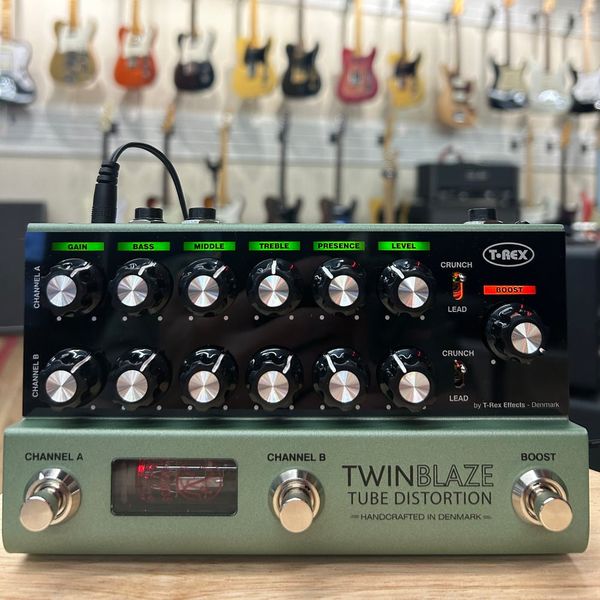
- Handcrafted in Denmark
- An identical two channel, tube driven Overdrive Distortion (12AX7A) spiced with the legendary T-Rex Tone and multiple functions.
- The extended tone control allows you to go from clear British sound to deep-end distortion, obtaining a variety of sound settings.
- Crunch and Lead setting for each channel, which goes from gentle, crispy blues to over the top lead sound.
- The emulated Speaker Simulation output is directed to the studio setup or other external effectS.
- A 20dB Clean Boost works individually to dial in the perfect solo level without changing the tone and gain structure.
- 12V power supply included.
.rbm-pick-card { --rbm-border: ; --rbm-accent: ; border: 2px solid var(--rbm-border, #e53e3e); border-radius: 10px; padding: 16px; background: #fff; font-family: inherit; position: relative; } .rbm-pick-badge { position: absolute; top: -10px; left: 12px; background: var(--rbm-accent, #e53e3e); color: #fff; font-size: 12px; line-height: 1; padding: 6px 10px; border-radius: 6px; font-weight: 700; } .rbm-pick-wrap { display: grid; grid-template-columns: 110px 1fr; gap: 16px; align-items: start; } .rbm-pick-img { aspect-ratio: 1 / 1; /* forces square crop */ overflow: hidden; border-radius: 6px; background: #f3f4f6; /* subtle placeholder */ } .rbm-pick-img img { width: 100%; height: 100%; object-fit: cover; /* crops without distortion */ display: block; } .rbm-pick-title { margin: 0 0 4px; font-size: 20px; font-weight: 800; color: #111; } .rbm-pick-sub { margin: 0 0 12px; font-size: 14px; font-weight: 700; color: #334155; } .rbm-pick-btns { display: grid; gap: 10px; max-width: 560px; } .rbm-pick-btns a { display: block; text-align: center; background: #000; color: #fff !important; text-decoration: none; padding: 12px 14px; border-radius: 8px; font-weight: 800; letter-spacing: .3px; } .rbm-pick-btns a span.price { text-transform: none; } .rbm-pick-btns a span.label { text-transform: uppercase; } /* Responsive */ @media (max-width: 560px) { .rbm-pick-wrap { grid-template-columns: 80px 1fr; } .rbm-pick-title { font-size: 18px; } }
T-Rex Twin Blaze
Sheptone® Unveils the 7078 Humbucker
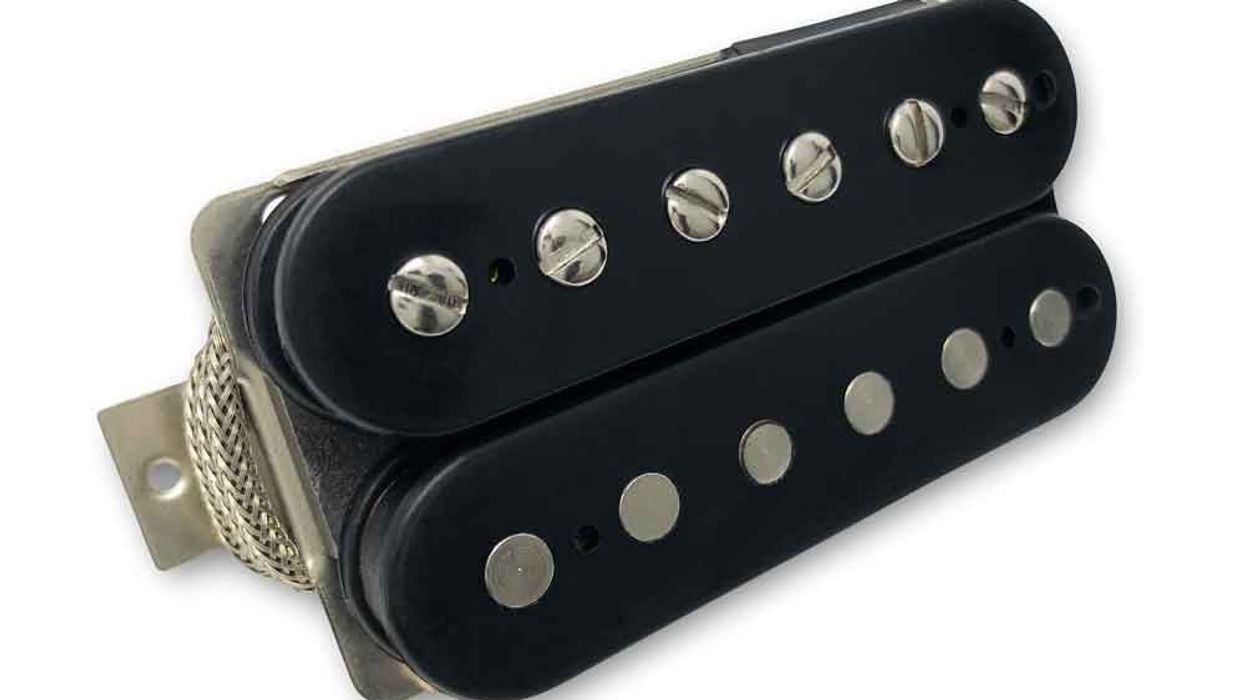
Sheptone® announces the 7078, a brand-new humbucking pickup inspired by the legendary tones that redefined rock guitar in 1978. Considered an industry secret for the past 18 years, Sheptone has been the “go to” for professional guitarists wanting to achieve that 1950’s tone that initially revolutionized electric guitar. The 7078 is the next step in the evolution of the Sheptone product line.
The 7078 pays homage to the iconic rhythm tones captured on Van Halen’s groundbreaking debut album. It was a sound that inspired generations of players and changed the way the world hears and plays the electric guitar. From the driving rhythms of You Really Got Me to the groove of Jamie’s Cryin’ and the raw fire of On Fire, the DNA of those unforgettable tracks lives on in the 7078.
At the core of that original tone was a stock 1975 Ibanez® Destroyer loaded with a Maxon® Super 70. The Sheptone 7078 recreates that magic with uncompromising authenticity, using the finest materials and painstaking craftsmanship. Each unit is hand-assembled by Sheptone owner and builder Josh Vittek, ensuring the detail and precision needed to deliver truly inspirational tone.
Using a rough cast, degaussed Alnico 8 magnet, the 7078 delivers articulate note definition and huge dynamics. The coils are computer wound with 42AWG plain enamel wire to Sheptone’s exacting specifications, ensuring consistent tone from pickup to pickup while staying true to vintage character. Sheptone’s proprietary double-black butyrate bobbins anchor the design, paired with German nickel silver baseplates that follow original-era specifications. Vintage braided hookup wire keeps period-correct authenticity, while the 49.2mm pole spacing and a resistance averaging around 7.7k complete the historically correct construction.
“This pickup is for a sure a future ‘secret sauce’ for many people's rigs. It really does things right! Harmonics in a second, the perfect amount of push on an amp yet while retaining complete clarity for clean playing to the most percussive metal rhythms my caveman wrist can throw at it. There's a certain sizzle near the mid highs that spikes your amp distortion in a way that I've not heard before. From the most basic of rock to the fastest, crustiest thrash, this pickup is quickly becoming my go-to,” said professional touring and studio guitarist, Charlie Bellmore of Jasta and Kings and Liars.
“The 7078 is more than a pickup. It’s a tribute to the sound that made so many of us pick up the guitar in the first place. Including me!” said Vittek. “I build each one by hand, with the same mindfulness and materials as I do all my other models. This may be the last pickup you’ll ever need… unless, of course, you own more than one guitar.”
The Sheptone 7078 is available now directly from Sheptone and through select dealers worldwide.
For more information, visit www.sheptone.com
Stompin’ to the Top: Meet Three of the Most Successful Independent Pedal Companies

We’ve been basking in the golden age of guitar-effects pedals for some time now, but somehow things just seem to keep getting better and better. Holy-grail tones have been decoded and transcribed into pedal form, even as radical new stompbox inventions give musicians the ability to create new ones. And guitarists’ pedalboards are no longer governed by the biggest names in pedal manufacturing. These days, you’re just as likely to see a Boss DS-1 on someone’s board as you are a one-off build from a friend of a friend.
The ground between the majors and the building-for-fun crowd is filled with passionate pedal makers who are changing how guitarists approach their instruments. In this piece, we’ll introduce you to three North American pedal companies who have changed the pedal game with unique sounds, community-minded approaches, and years of hard work—plus, a quick word on their top stomps.
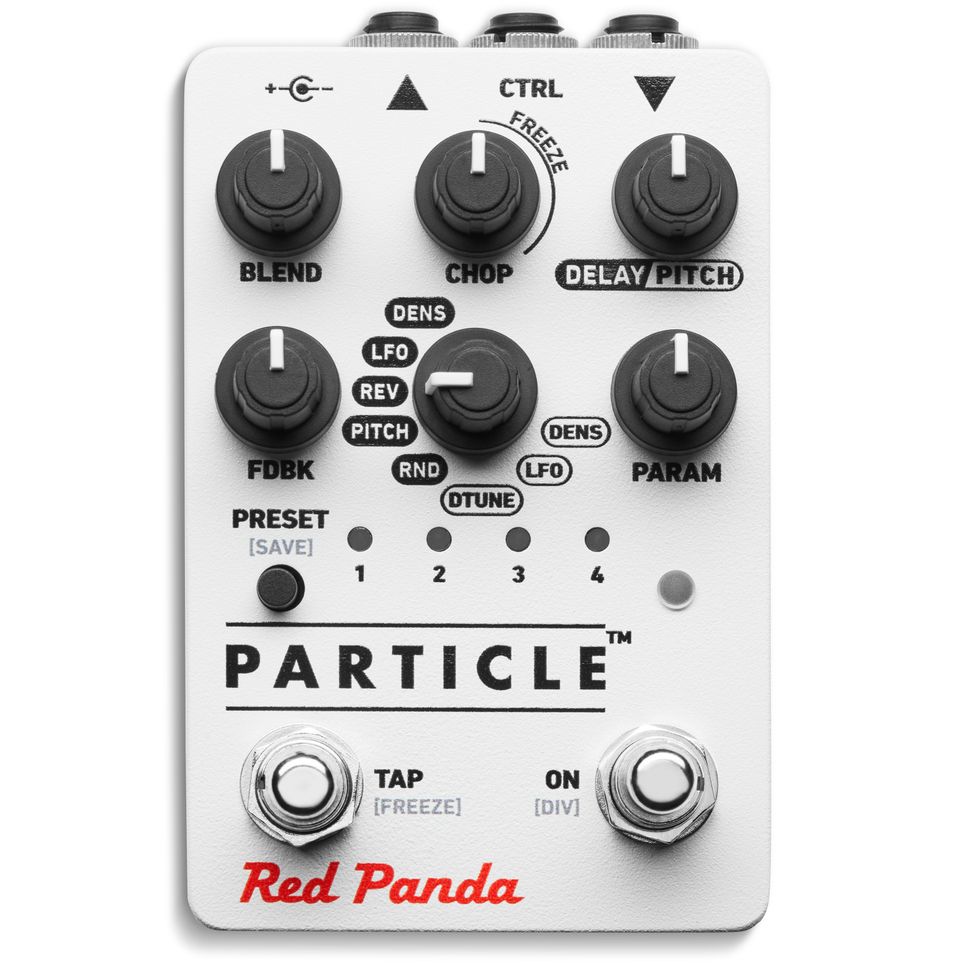
Red Panda
Biggest Hit: Particle
The Story:
Curt Malouin isn’t a guitar player, and he didn’t set out to make guitar-effects pedals, yet that’s exactly what happened with Red Panda. Malouin was working a demanding software engineering job and had been building modular software for 15 years before he started soldering pedals in his garage in 2009, but his love for electronics began when he was 11. Malouin says that having Asperger’s syndrome facilitated his obsession with sound: “I was really super interested and focused on using algorithms to manipulate sound and zoom in on little details of the sound,” he says. “It’s what my brain is focused on most of the time.”

Malouin messed around with drum machines, synths, and turntables when he was growing up in metro Detroit, listening to techno and hip-hop created in the city. Pedals were of a piece with those scenes: tools in a sound creator’s kit that were highly tweakable and allowed for brilliant manipulation, like how DJs and hip-hop artists used both old and new technologies to create unique sounds. When Line 6’s ToneCore pedals, like the Echo Park delay and Verbzilla, dropped, Malouin discovered that they included interchangeable modules that allowed users to modify the DSP code. It happened to be the same code he used in college while studying electrical engineering. That helped bridge his expertise with his new interests. “It was a combination of wanting to get back to something a little more simple and physical than working on software,” he says.
In 2011, Red Panda released the Particle, Malouin’s first ground-up design and the first-ever granular delay pedal. Word spread about this one-man operation building deeply featured digital pedals. Four years later, Malouin moved to a shared workshop. Another five years passed before Red Panda moved into its current office and workshop.
Red Panda’s builds are entirely digital, and feature-wise, they’re more complex than your average stomp. As a rule, they’re equipped with stereo inputs and outputs, full MIDI implementation, and web-based editing. Malouin is the engineer behind every step of their creation—he even built the operating system that runs the algorithms and digital signal processing (DSP) code. Malouin says that involvement keeps Red Panda’s conceptual integrity consistent from top to bottom.
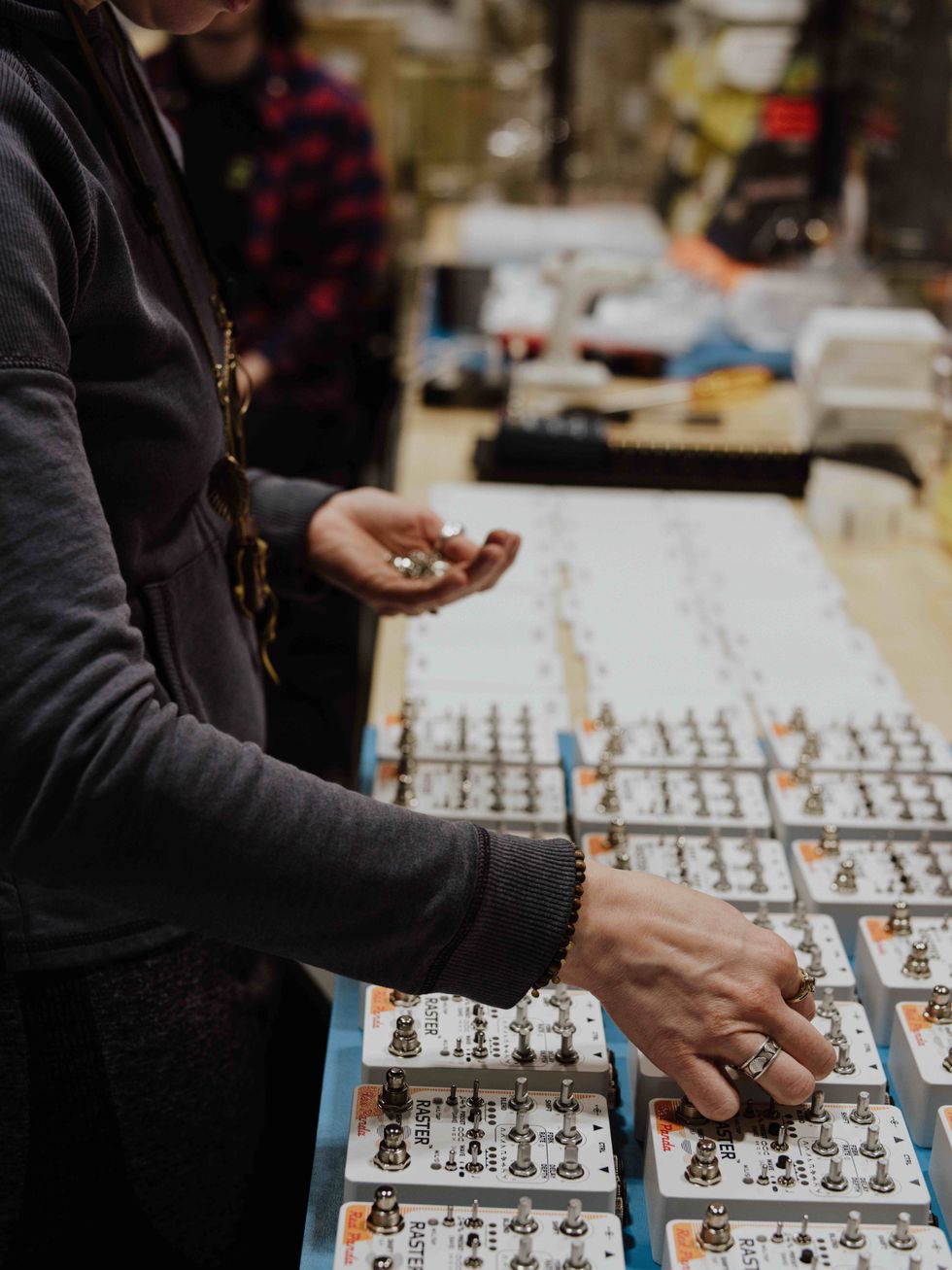
Red Panda’s new RD1 series, which has been in development for three years, aims to deliver these designs in a pared-back, more affordable package. They’ll feature the same algorithms as the flagship products, but with fewer features and more focused applications—something like an old-school pedal that “does one thing, and does it really well,” explains Malouin. “There’s a lot of fun engineering challenges in trying to keep something that sounds just as good as our other pedals, but we can sell at a lower price point that allows musicians to grab it and make interesting music.”
The pedals were ready to go in April this year, but Donald Trump’s volatile tariff applications made it impossible to meet the price target Malouin wanted to hit. Red Panda’s pedals are all assembled in Michigan, but he sources parts from around the world, many of which Malouin says will never be made in the U.S. He adapted by, once again, leaning on new processes to reduce costs; for example, designing the pedals to be as quick to assemble as possible, or replacing several components with one that can do multiple things. “It’s a little engineering magic trick that makes this work fun,” he says.
Red Panda has grown since its beginning, but not by much. Malouin and only three others are day-to-day, full-time workers, which means everyone handles a bit of everything, from assembly to orders to shipping to video productions.
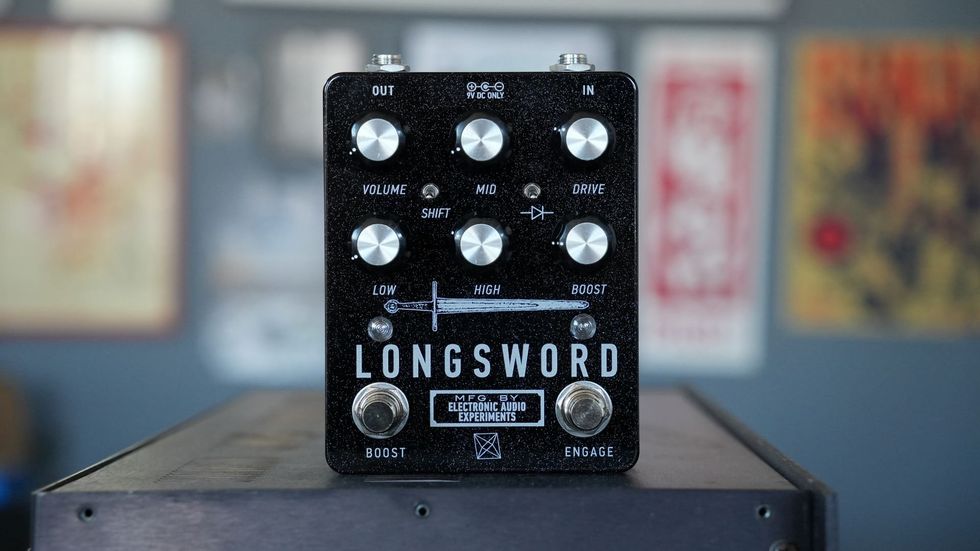
Electronic Audio Experiments
(electronicaudioexperiments.com)
Biggest Hit: Longsword
The Story:
It’s been just over 10 years since Boston-based pedal builder John Snyder released the first version of the Electronic Audio Experiments Longsword, but it wasn’t until 2020, when he began building full time, that the pedal reached its final form.
If you’re curious, though, you can see exactly how the Longsword evolved over the years. Snyder tracks and publishes all the changes to each of his pedal’s circuits over the years on EAE’s website. “For me, it was partly to quell confusion on the internet where people were like, ‘This version of this pedal has this thing and this version has this thing,’ or people saying, ‘I have this serial number, when did you change the board?’ I can just say, ‘Here’s the change log, it’s on the website, it’s in the manual.’ I wish other companies would do something similar.”
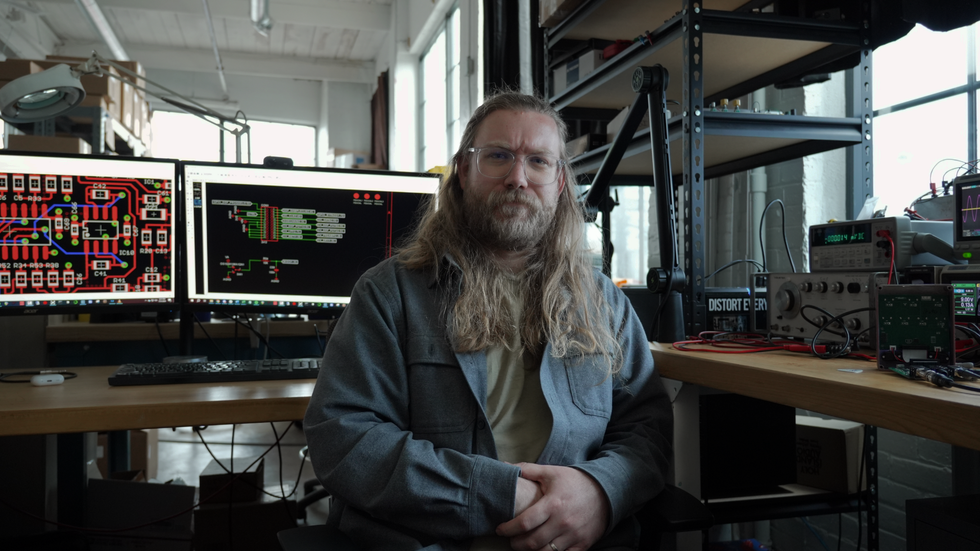
Snyder began playing in bands in middle school, and during his college years in the early 2010s he was active in the Northeast’s DIY community of emo, punk, and hardcore bands of all stripes. Influenced by a family heritage of engineers (one of his grandfathers was head of quality control at a vacuum-tube plant in Kentucky), Snyder was always the token gearhead in his circle. His bands were never too popular, which meant he had more time to focus on crafting unique sounds between short tours and weekend runs.
Dirt lovers around the world have a rare meteorological phenomenon to thank for their EAE pedals. In early 2014, Boston received more than 20 inches of snow over two days. Snyder was snowed into his illegal basement apartment, unable to visit his girlfriend (now wife) or any friends. It was during these locked-in days that Snyder breadboarded the Longsword. He built one for himself, and the following summer he sold a batch of 15.
Snyder finished a post-grad degree in electrical engineering in May 2020, and outside of the defense industry, there weren’t many prospects. After his wife suggested that he focus on building pedals, Snyder spent three months working on streamlining his processes. That turned into six months, which turned into a year. The operation didn’t fit into Snyder’s guest room anymore, so he upgraded to a real shop space for a while before landing on EAE’s current location, a corner of the second floor of a warehouse in Waltham, Massachusetts. (Their downstairs neighbours are Small Bear Electronics.)
“We’re all helping each other, which is a really awesome way to build community and make what we do more interesting. Something that I try to keep in mind is that this industry is so, so small, and we’re not really competing with each other.”–John Snyder, Electronic Audio Experiments
The Longsword was born from Snyder chasing the solid-state and op-amp distortion sounds of classic post-hardcore acts like Touché Amoré, La Dispute, and mewithoutYou. The Longsword’s lineage includes elements of the Boss HM-2, MXR Distortion+, and the Caroline Wave Cannon (which itself has some RAT DNA), but Snyder added a Baxandall EQ circuit. “I wanted something that didn’t already exist in the market and was very purpose-driven in its design, and could be unique enough to stand out,” explains Snyder.
Snyder credits mentors like Nick Williams of Dunwich Amplification with sharing their time and expertise in EAE’s early days: “[Nick] taught me a lot of the basics of, like, ‘How do I lay out circuit boards? How do I order circuit boards? Where do I find parts and stuff?’” Others shared meat-and-potatoes tips like how to drill enclosures in a bedroom without getting aluminum shavings everywhere, and how to market and build artist relations. Snyder tries to pay it forward these days by helping out new builders. “We’re all helping each other, which is a really awesome way to build community and make what we do more interesting,” says Snyder. “Something that I try to keep in mind is that this industry is so, so small, and we’re not really competing with each other. We’re all competing with Amazon Basics and Behringer.”
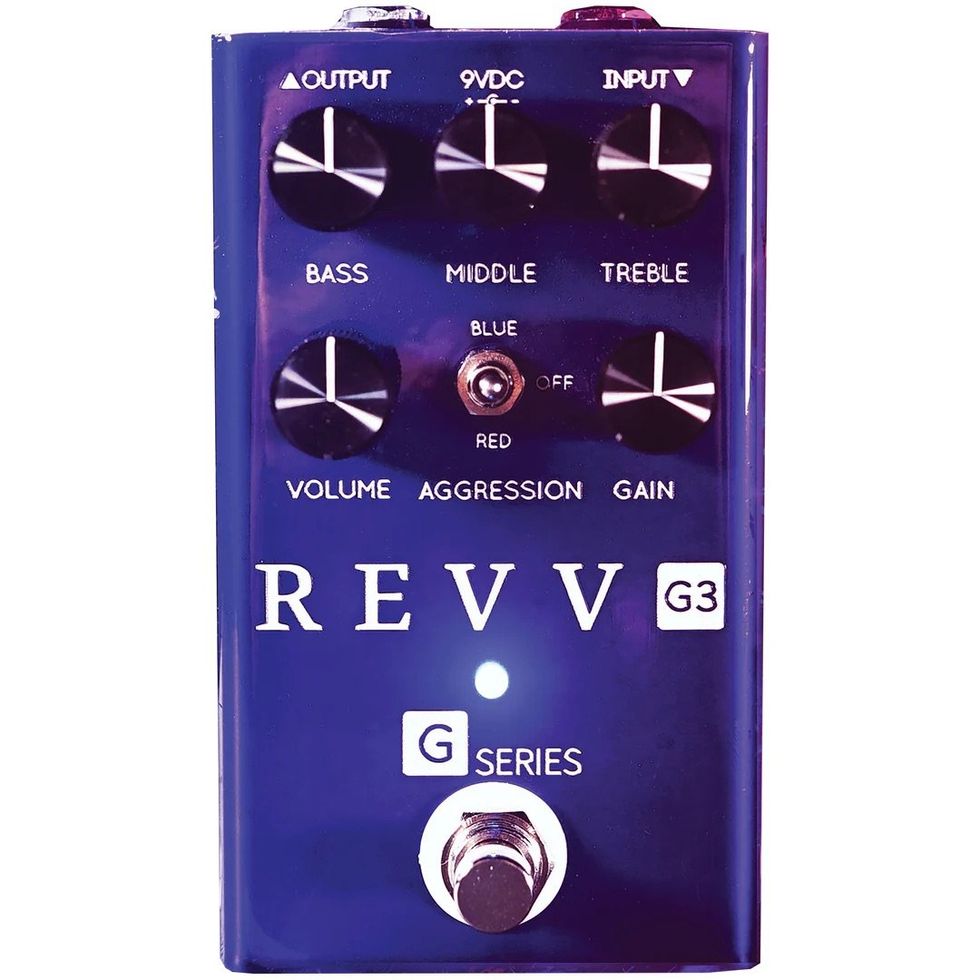
Revv
Biggest Hit: G3
(revvamplification.com)
The Story:
Winnipeg’s Revv Amplification made their name on the reputation of their excellent high-gain amplifiers, like the Generator 120. The 4-channel, flagship amp head was the sound in lead designer and president Dan Trudeau’s head. Trudeau, along with vice president of sales and marketing Derek Eastveld, took the formula a step further in 2018 when they put Revv’s rich, articulate, ground-shaking dirt into stompbox format.
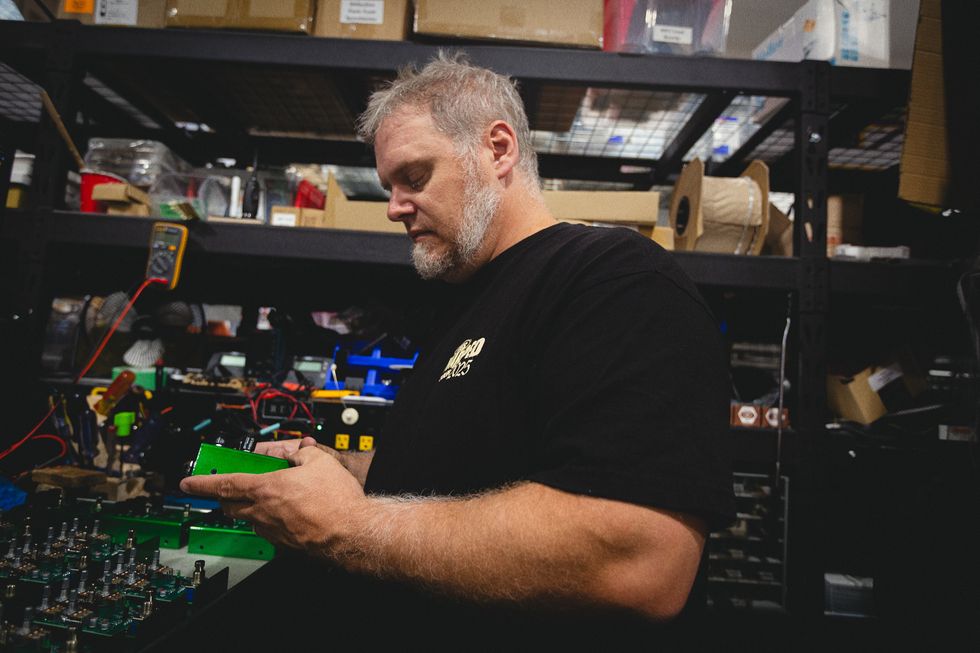
The day Revv’s G3 pedal launched in May 2018, Eastveld was on a flight to Germany. He and his colleagues had figured they would sell 250 of them in a year. By the time he landed later that day, they’d racked up 270 sales through their website. By the end of the month, they had more than 1,000 orders to fulfil. The success was exciting, but it also posed a problem: Revv only consisted of four full-time workers. The fateful launch provided the cash flow needed to scale up the company, and today 20 people work full-time for Revv, across production, marketing, sales, design, and administration.
Revv’s amp-in-a-box G-series pedals—G2, G3, and G4—are color-coded according to the corresponding channel on the Generator 120. The G2, for example, is green, because when the namesake amp’s second channel is engaged, the amp’s LED glows green. Eastveld says that means some people mistake the pedal for a Tube Screamer clone, which is a big mistake. The G2 is much more saturated and modern-sounding. Eastveld describes it as splitting the difference between contemporary high-gain monsters like Mesa Boogie Rectifiers and 5150s, and mid-gain classics like vintage Marshalls. The purple G3, though, remains Revv’s top-selling pedal. It’s even more modern, mid-focused, and aggressive, with a 3-position switch to navigate between different voicings and saturation levels.
“We’re always taking notes about like, ‘Okay, what did people respond well to, and what do we need to take another look at?’”–Derek Eastveld, Revv
Eastveld and Trudeau pride themselves on staying flexible and responsive to their users. They constantly monitor their social media for comments and suggestions. “Maybe somebody bought something and then sold it because it wasn’t a right fit for them, and we’re always taking notes about, like, ‘Okay, what did people respond well to, and what do we need to take another look at?’” explains Eastveld. That openness has led directly to amp and pedal upgrades. The G series pedals, including the famed G3, got a V2 makeover this year.
MayFly Audio releases the Terrain Deluxe Harmonic Optical Tremolo

The Terrain Deluxe is a Harmonic Tremolo with Tap Tempo, featuring a high fidelity all analog signal path using LightDependent Resistors (LDRs) for modulation. The Harmonic Tremolo mode uses an electronic crossover to split the signal into high and low frequency components.These are modulated 180 degrees out of phase and then re-combined creating a wet, lush tone. Speaking of tone, theTone control pans between the high and low frequency signals, going from full treble to full bass and everything in between. In the unlikely event that you get tired of the beautiful Harmonic Tremolo there is a Normal / Harmonic mode switch. In Normal Mode the high and low components are modulated together creating a traditional tremolo sound.
There are Speed, Depth, and Gain controls, and a Waveform switch to select between square, sine, and triangle waveforms.The Tap Tempo foot switch works win conjunction with the Tempo Multiplier switch allowing you to create quarter note, eight note, and eight note triplet modulations by just tapping the base tempo. The two tempo LEDs above the footswitch flash together in for Normal mode and 180 degrees out of phase in Harmonic mode.Finally, there are two independent expression pedal inputs: one each for Speed and Depth.
• Harmonic Tremolo with Tap Tempo.
• High fidelity all-analog signal path using LDRs.• Speed, Depth, and Gain controls.
• Tone control that sweeps between high and low frequency signals (center is flat).
• Normal / Harmonic mode switch.
• Sine, Square, and Triangle waveform switch.
• Tap Tempo footswitch with Tempo Multiplier switch.
• Independent expression pedal inputs for Speed and Depth controls.
• Full bypass with Fail Safe® using relays.
• 9VDC, 80mA.
MAP price: $220 USD ($299 CAD).
StewMac Launches Guitar Pedal Line With Four Hot Models
Building on the foundation of the company’s acclaimed pedalkits, StewMac has introduced a line of ready-to-play, fully finished guitar effects pedals.
The newly launched models include StewMac’s four most popular pedal designs: the Sun Fuzz; Lightcycle Phasor II optical phaser; Two Kings Boost dual overdrive; and Ghost Drive transparent overdrive. Each pedal delivers classic tone at an incredible price.
Sun Fuzz
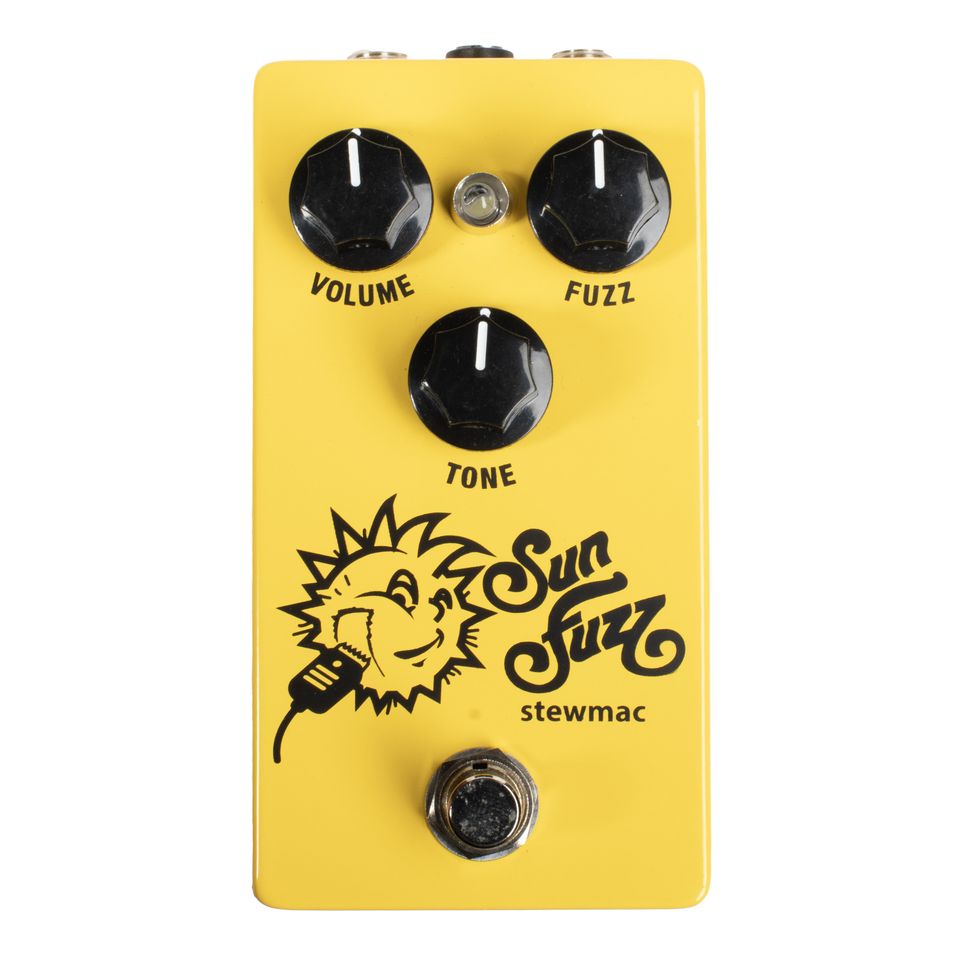
There have been countless replicas and reimaginations of the classic Fuzz Face pedal. StewMac’s Sun Fuzz gives you the control and tone shaping you've always wanted from the originals, and it’s a must-have for fans of Hendrix, Clapton, or Gilmour’s tone.
This circuit is one of the foundational tones for electric guitar, but the germanium powered originals can be hard to control and don't play nice with many pickups and amps—even temperature can completely change the tone! To create a more predictable, controllable, reliable tone, we've swapped the germanium transistor for a silicon BC-108, giving the pedal a brighter tone, more gain, and enhanced touch sensitivity.
Priced at $99.99, the Sun Fuzz is a no-brainer for fuzz fans who don’t want to shell out $200+ for the originals. Key features include:
- Improved bias control and tone shaping compared to the originals.
- Silicon BD-108 transistor.
- Versatile fuzz with simple controls for volume, fuzz, and tone.
- Sounds great with humbuckers, single-coils, and P-90s alike.
Two Kings Boost Dual Overdrive
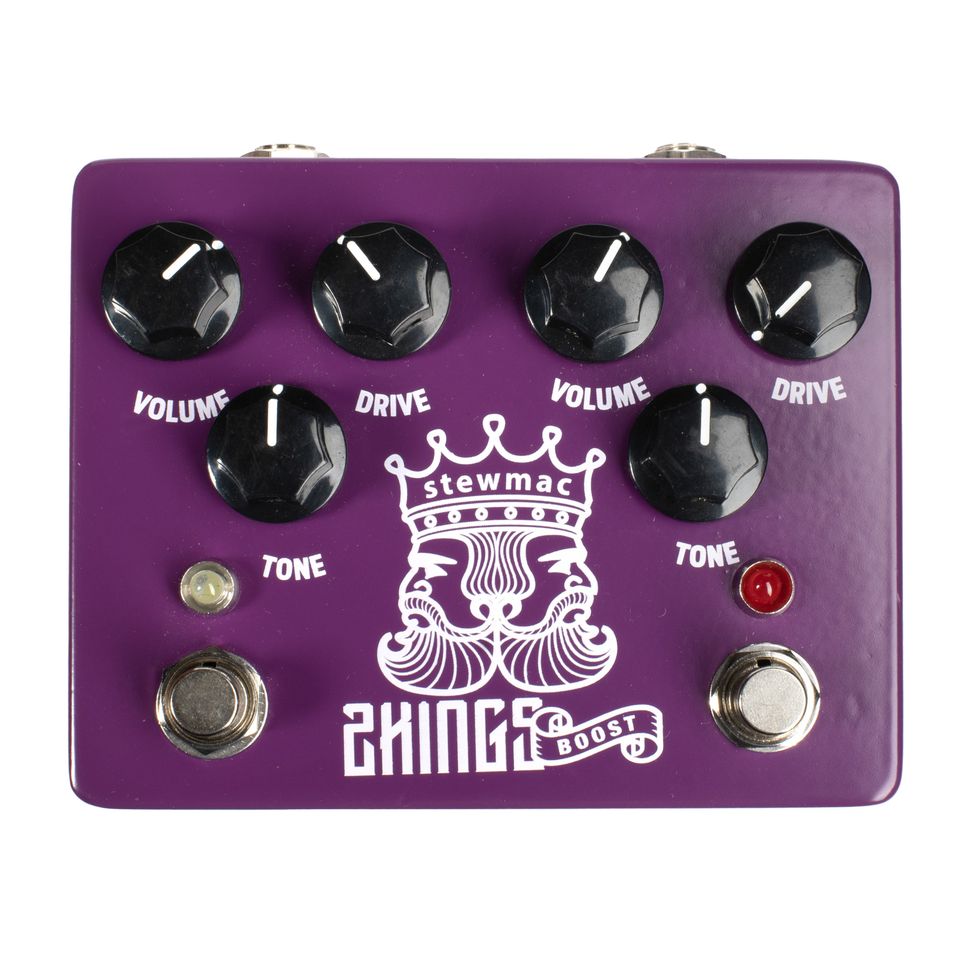
Inspired by one of the most sought-after dual overdrives on the market, players like John Petrucci, Gary Clark Jr., Samantha Fish, and Warren Haynes have raved about the originator of this circuit, the King of Tone. Now, you no don’t have to wait to add this circuit to your rig. StewMac’s Two Kings is transparent but still warm and gritty, with a full range of frequencies available—no matter the setting. It won't overpower the unique tone of your guitar and amp—it just makes it better.
The Two Kings is actually two pedals in one, with selectable boost and distortion through internal dip switches. The two sides of the pedal are completely independent—it's easy to find the sweet spot for each side. With knobs for gain, volume, and tone you can get anything from simple boost, gritty overdrive, and even distortion in a flash. If you want to go deep, you can further tailor the sound with the internal controls for infinite tone tweaking.
Priced at $199.99, the Two Kings is an affordable and authentic alternative to the pricey, hard-to-get original. Key features include:
- 2-in-1 pedal.
- Maintains core tone of guitar and amp.
- Effortlessly provides boost, gritty overdrive, and distortion.
Lightcycle Phasor II
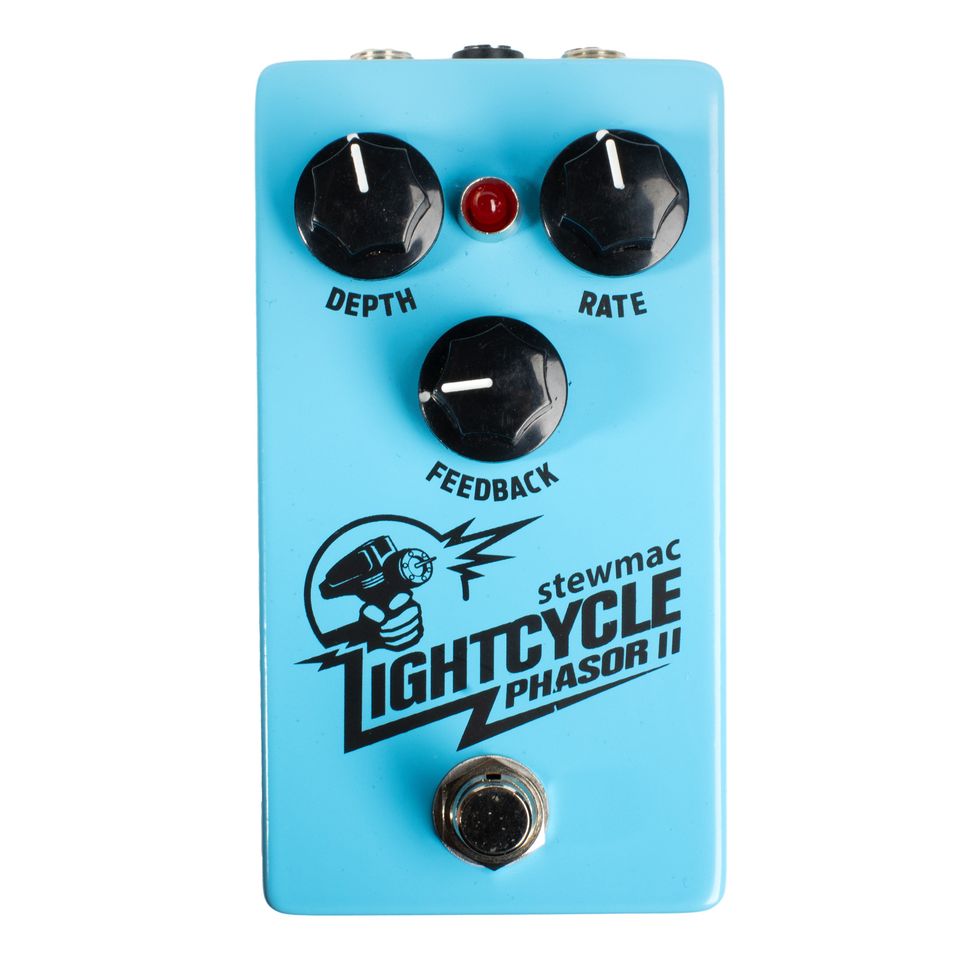
This isn’t just another phase shifter—it’s the unmistakable sound of deep, liquid movement that defined an era. Inspired by the MuTron Phasor II from the 1970’s this studio-quality, all-analog optical phase circuit set the gold standard for smooth, sweeping modulation. StewMac has recreated this timeless classic to bring your tone to life with the same lush, organic depth that graced the pedalboards of legends. You can recreate those complicated textures live—from a rotary speaker shimmer to wild spacey soundscapes, every knob twist sparks inspiration. On the front are controls for depth, rate, and feedback, letting you dial in anything from subtle swirl to rapid tremolo and synthesizer sounds. For even more flexibility, two internal controls let you dial in the sweep and intensity of the phased signal.
Priced At $149.99, the Lightcycle Phasor II is an authentic and affordable alternative to the original. Key features include:
- Studio-quality optical phaser.
- Controls for depth, rate, and feedback.
- Two internal controls to adjust the sweep and intensity of the phased signal.
Ghost Drive
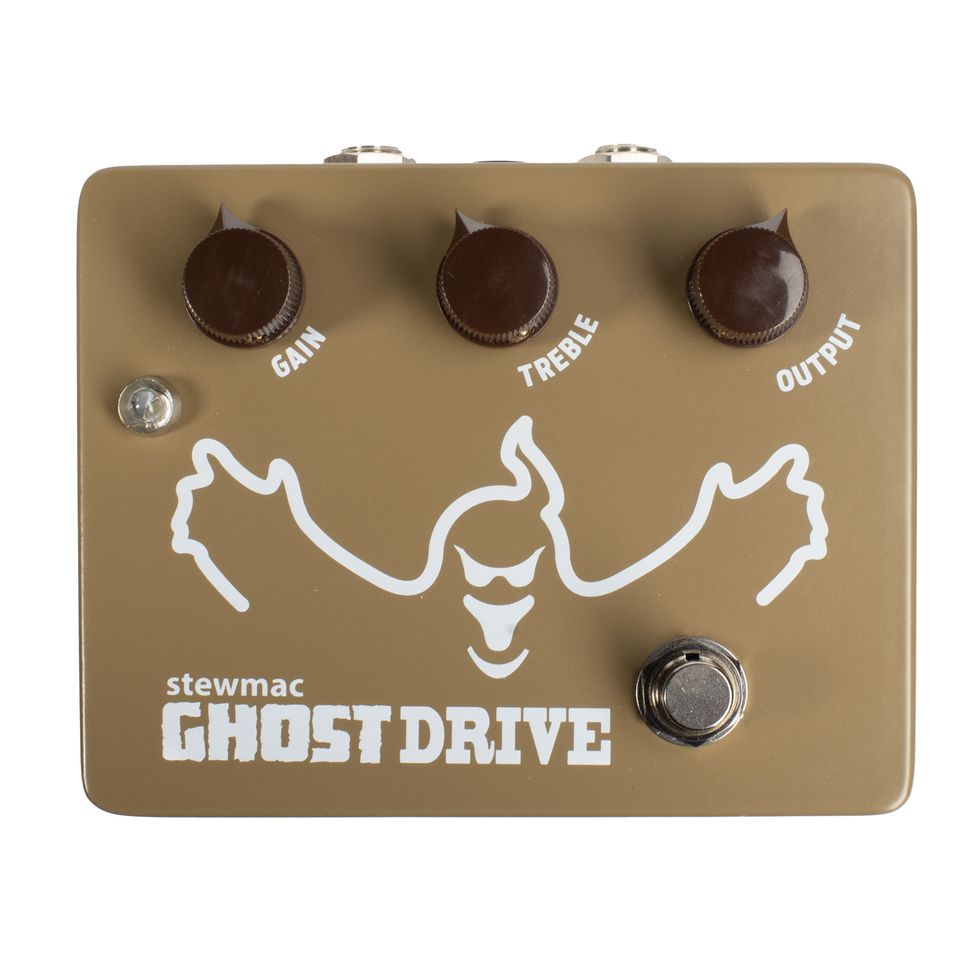
Not just another “klone”, the StewMac Ghost Drive pedal is the closest to the famed Klon Centaur Professional Overdrive we’ve ever heard. StewMac scoured the globe to source the nearly impossible to find (electronically identical) 1N34A germanium diodes that many claim were the heart and soul of the mojo behind the original Klon. Also, unlike so many modern klones that rely on surface mount components, the Ghost Drive is pure old school using through-hole components and traditional solder joints. This gives the pedal the purest tone possible and makes it a true match to the originals. The Klon was made famous by countless players like Joe Perry, Mike McCready, Joe Bonamassa, John Mayer, Nels Cline and more, but at more than $5,000 for a vintage original the StewMac Ghost Drive Pedal
This pedal is extremely easy to use: just gain, treble, and output. The gain is where the magic is by adding sweet saturation and harmonics while retaining the character of your amp. The treble acts as a boost or cut, allowing you to dial in the perfect mid-range for your tone.
Priced at just $149.99, the StewMac Ghost Drive provides a nearly identical tone for just a fraction of the price of the originals. Key features include:
- Through-hole components and traditional solder joints just like the originals.
- The electronic identical 1N34A germanium diodes in the originals.
- Works great as a clean boost as well as a transparent overdrive.
- Buffered bypass.
For more information about StewMac’s new line of pedals visit stewmac.com
Now Available: UAD Shadow Hills Mastering Compressor Class A and Maag EQ4 MS Plug‑Ins
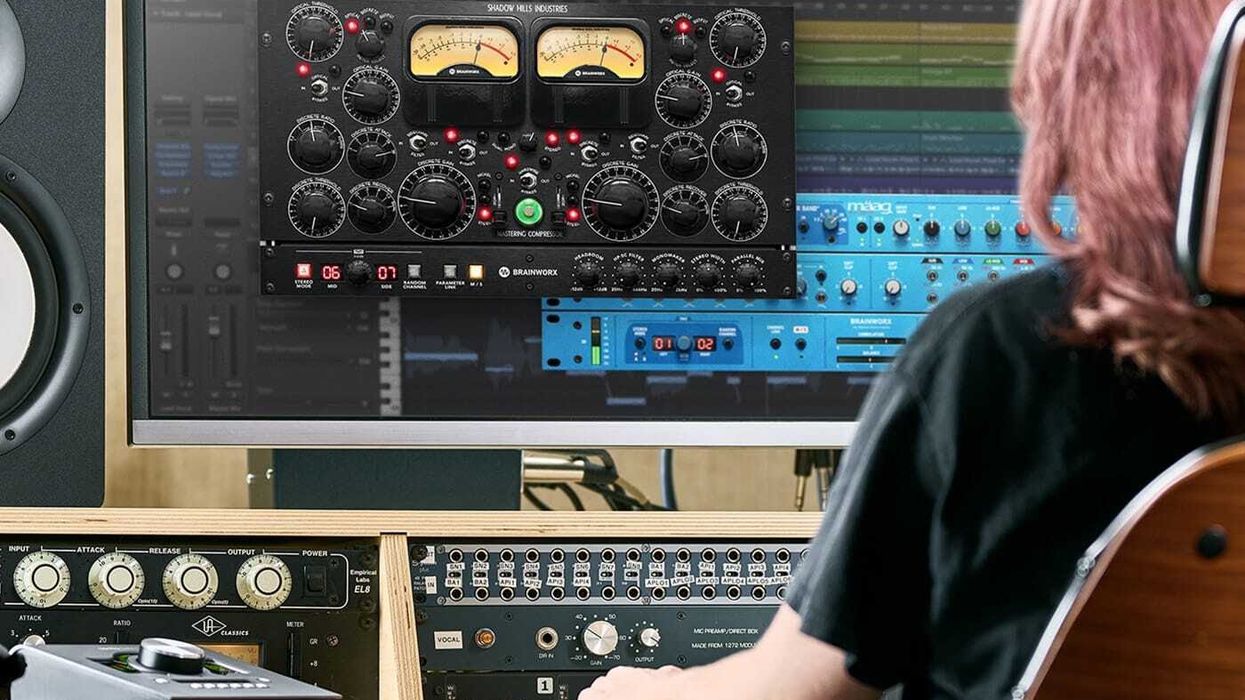
Universal Audio, a worldwide leader in audio production tools, today announced the release of the Shadow Hills Mastering Compressor Class A and Maag EQ4 MS plug‑ins. As a part of the Apollo and UAD v11.8 software update, these plug‑ins deliver enhanced sonics, with new features and workflows for modern music producers and engineers, or those looking to upgrade their current Shadow Hills or Maag plug‑ins.
UAD Shadow Hills Mastering Compressor Class A – $169 USD
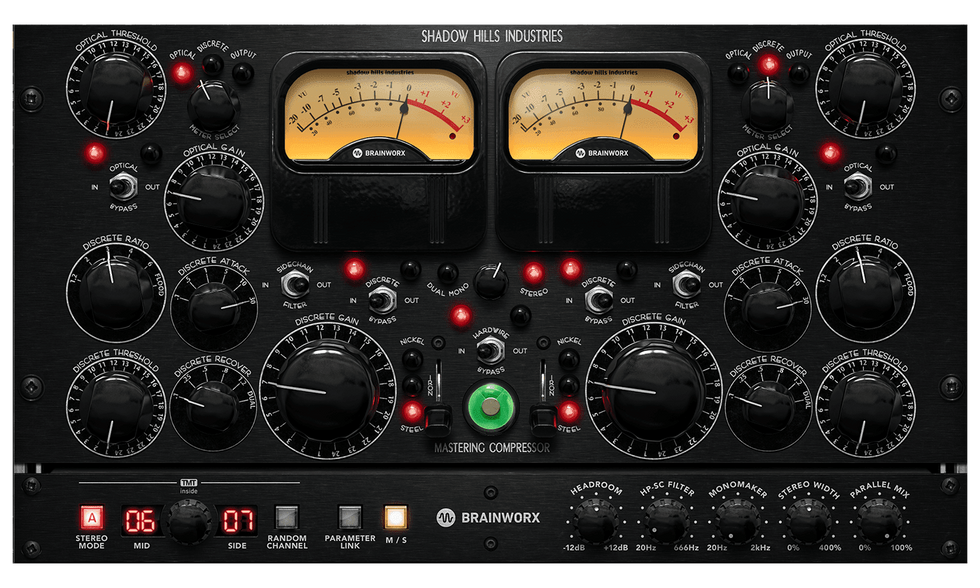
“Shadow Hills Class A and Maag EQ4 MS give music creators access to two rare and unique sounds in the UAD catalog,” says Lev Perrey, VP of Product at Universal Audio. “Beyond the updated UI, they add entirely new sonics and workflow capabilities, expanding what’s possible for customers working with Apollo interfaces and UAD hardware.”
The Shadow Hills Mastering Compressor Class A plug‑in is a meticulous emulation of the legendary “Red” edition hardware — of which only 50 units were ever built. It delivers the coveted dual‑stage optical and discrete compression stages, plus switchable Nickel, Iron, and Steel output transformers so you can dial in open and airy detail to thick, saturated tone.
Sonically enhanced with Tolerance Modeling Technology by Brainworx (TMT), the updated Shadow Hills UAD plug‑in features the subtle channel‑to‑channel variations of the real analog gear, giving mixes added depth and realism. Customers can also access powerful features including Mid/Side processing, Stereo Width control, Mono Maker, Parallel Mix, scalable UI, and more — going far beyond the original hardware.
Shadow Hills Mastering Compressor Class A - Key Features
- Updated version of rare Class A dual‑stage optical and discrete compressor plug‑in
- TMT technology by Brainworx adds subtle channel‑to‑channel variations for greater analog realism
- Switchable Nickel, Iron, and Steel output transformers for unique tone shaping
- Enhanced Class A circuitry with 1–3 dB hotter presence than the original UAD plug‑in
- Plug‑in only features: Mid/Side, Parallel Mix, Stereo Width, Mono Maker, Sidechain Filter
UAD Maag EQ4 MS — $129 USD
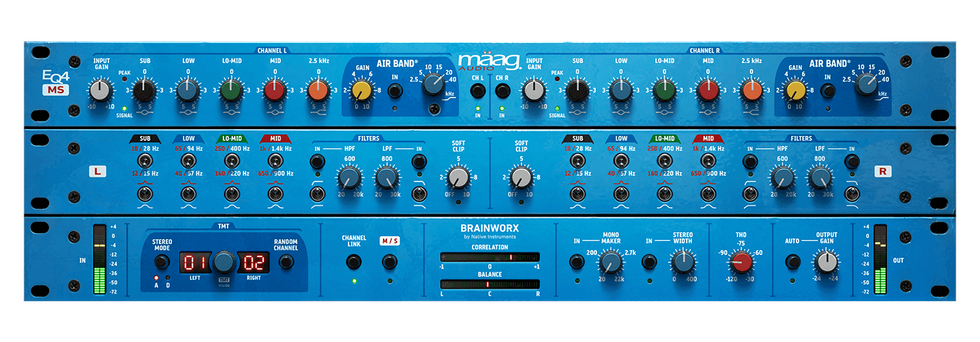
The Maag EQ4 MS plug‑in brings life to a classic UAD plug‑in title. Along with its iconic Air Band, the new version features Mid/Side processing, expanded frequency choices, selectable Q values.
Ideal for adding presence to vocals and instruments, the Maag EQ4 MS now brings extra clarity and depth to mixes thanks to TMT technology by Brainworx — which captures the real‑world channel variations that add analog realism unlike other matched digital EQs.
Maag EQ4 MS - Key Features
- Updated edition of the legendary EQ4 plug‑in with expanded sonics and flexibility
- TMT technology by Brainworx captures natural channel‑to‑channel differences for extra width and dimension
- Iconic Air Band delivers transparent, musical high‑end sheen for vocals and instrument
- Mid/Side processing tools for precise control of stereo image and depth
- Expanded frequency options and selectable Q values for refined tone shaping
Also included in the UAD v11.8.1 update, MIDI Learn is now available for all UAD DSP plug‑ins, giving customers hands‑on control of plug‑in parameters with compatible MIDI controllers. With a simple click, touch, move workflow, music producers working in Apollo studios with UAD plug‑ins can map knobs and faders in seconds — eliminating tedious menu diving.
Pricing & Availability
- The Shadow Hills Mastering Compressor Class A plug‑in is available for $169 (new customers) or $39 (upgrade price).
- The Maag EQ4 MS plug‑in is available for $129 (new customers) or $39 (upgrade price).
- Both plug‑ins, along with MIDI Learn functionality, are included in the Apollo & UAD v11.8.1 software update, available September 4, 2025.
Learn more about Shadow Hills Mastering Compressor Class A:
uaudio.com/products/shadow-hills-mastering-compressor-class-a
Learn more about Maag EQ4 MS:
uaudio.com/products/maag-eq4-ms
Learn more about UAD Plug‑Ins:
uaudio.com/collections/uad-plugins
Download images and press materials:
Vox V863-CA Review
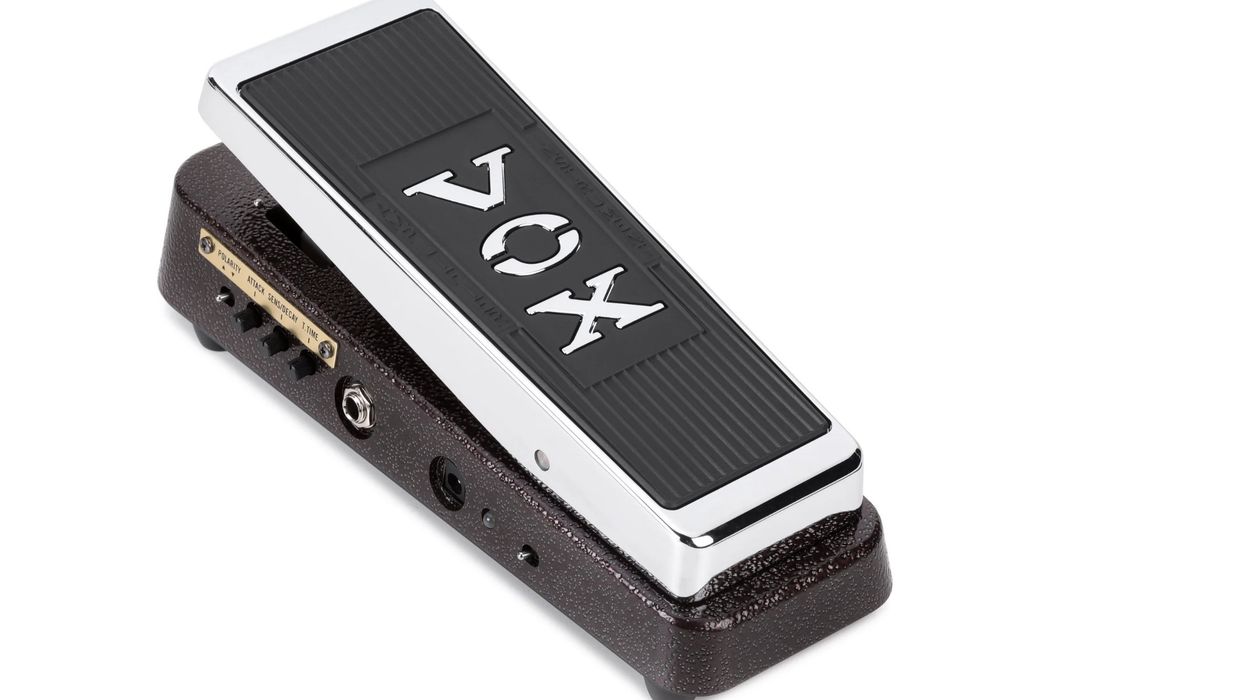
A 3-in-1 wah, envelope follower, and envelope controller that opens up a huge range of filtering possibilities.
As an avid—perhaps rabid—musical psychedelicist, I’ve had a lot of wah in my life. Maybe too much. In recent years, I seem to have had my own personal version of the rock world’s 1968 epiphany, where everyone ditched their wah and fuzz, moved to the country, and put Music from Big Pink on constant replay.
Recently, though, I’ve been in touch with my wah side again—this time by way of JJ Cale’s chilled out swells and Curtis Mayfield’s mellower wah flourishes. And through these applications of treadle-actuated filtering, I’ve rekindled my love for the more psychotic side of the effect. Vox’s V863-CA will happily wind along either the gentle path or the hard road. It has a nuanced filter taper that makes slow, focused sweeps sound sweet and vocal, and it responds to quick-twitch moves with precision. But the real magic in the V863-CA is its combination of envelope generator (auto wah) and envelope follower functions, as well as its ability to switch between wah and the two filtering modes merely by lifting your foot from the treadle.
It Just Takes A Touch
You can only use either the envelope generator/wah combination or the envelope follower/wah combo at any given time—a small price to pay for the versatility at hand here. You can, however, select between those two modes with a small mini toggle on the lower left side of the enclosure—which, incidentally, seems well out of the way of accidental triggering. There is a third position for wah only, which is useful for accessing cocked wah tones. But you can switch any of the effects into bypass mode with a click in the toe-down position.
Vox’s V863-CA will happily wind along either the gentle path or the hard road.
Inspired by Dead and Company’s recent shows celebrating the Grateful Dead’s 60th anniversary, I explored the envelope follower section of the V863-CA in honor of Jerry Garcia. The V863-CA performs admirably in this capacity. Using the polarity switch, you can shape the filter’s reaction to a dynamic trigger. In one mode the filter’s voice opens with a “wow”-like tonality; in the opposite polarity it yields a snappier effect. It’s a pretty sweet-sounding envelope filter, too—particularly in the more open, vowelly, Garcia-like mode. The sensitivity control, which governs the filter’s reaction to picking dynamics, isn’t the most nuanced, and I preferred to keep the sensitivity wide open and control the sound via my picking and guitar volume (which can dull the dynamic response if you turn down too much). Still, the biggest thrill of using the envelope follower mode was the ability to launch from a chilled, quacky, Garcia run to Eddie Hazel “Maggot Brain” intensity just by putting my foot on the treadle. This is a genuinely inventive feature that will open up possibilities to players outside the psychedelic sphere.
The envelope generator, or auto wah function, can be shaped with both the decay control and the attack knob, which manipulate the filter’s reactivity. (Both knobs have useful center detents). Between the two controls you can craft syrupy response for spacey, slow jams (delicious with loads of delay) or snappy, funky interactions that will keep up with rapid-fire Nile Rodgers-style licks.
At $279, Vox’s Vietnam-made V863-CA seems expensive until you dig deep into its bag of tricks. And though it might appear specialized, I had little problem finding novel uses of the combination effects that broke the funky and acid-fried wah molds and led to more unusual ends. But the coolest part of the V863-CA experience remains the ability to seamlessly move from wah to filtering functions simply by lifting one’s foot. It’s a smart way to shift between verse, chorus, and solo segments without tap dancing between multiple pedals. The same functionality can generate dramatic changes in mood and dynamic, inspiring whole compositions and arrangements. In that respect, the V863-CA delivers value in abundance.
Red Light Fright
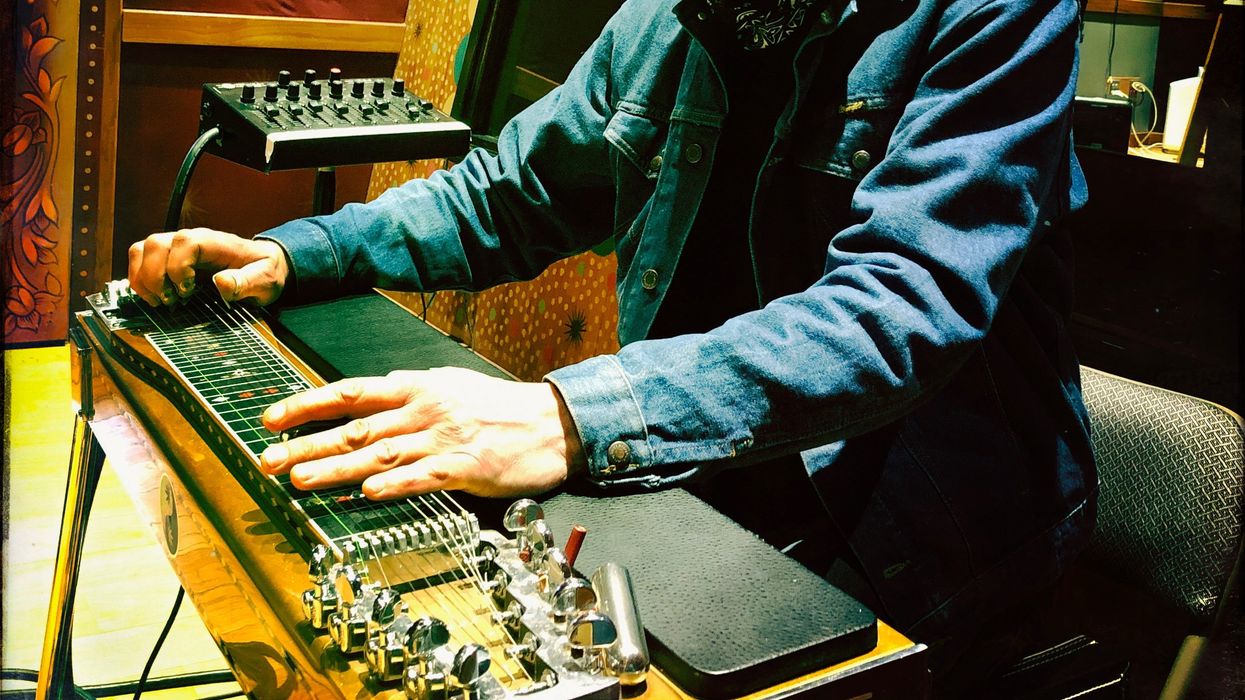
In the 1999 cult classic Mystery Men, Invisible Boy has a superpower that’s as hilarious as it is relatable: He’s invisible, but only when no one’s looking. The moment eyes are on him, he’s just a kid in a cape, exposed and ordinary. Musicians, doesn’t that hit home? When it’s just you and your guitar, the music flows like a river—raw, unfiltered, alive. But flip on the studio’s red light or face a sea of cell phones at a gig, and that river can dry up fast. It’s the red light paradox: The act of capturing inspiration often chokes it.
Players like Marcus King, Masayoshi Takanaka, and Tom Bukovac seem to live in that effortless zone, channeling endless streams of soulful licks. Alone in a room, you might tap into that, too—those late-night jams where riffs cascade and ideas feel infinite. No stakes, no judgment. Only creation. But in the studio, that red light is a judge with a gavel. Every note feels etched in stone, ready for eternal scrutiny. The ticking clock, the producer’s glance, the knowledge that a single take could live forever—it’s enough to stall the flow.
I’ll never forget filming a Rig Rundown with Thom Bresh in 2020. Thom was an absolute legend with talent that drove an incredible seven-decade career. Before we started, I said, “Hey Thom, want to play something going into the interview?” He paused, grinned, and replied, “Been playing my entire life, but the minute somebody asks me to play, I got nothing. My mind goes blank.” If a giant like Bresh could feel that pressure, what hope is there for the rest of us mere mortals? It’s proof that the red light doesn’t discriminate.
“It’s not about nailing every note; it’s about capturing something true.”
Live music, though, is a different beast. There’s freedom in the fleeting moment. The crowd’s energy, the vibe with bandmates, the knowledge that a flubbed note vanishes by the next song—it all invites risk. I’ve seen players, myself included, get bold onstage in ways we’d never try in the studio. You’ll stretch a phrase, chase a wild harmony, or lean into a bend that might not land, because it’s yours and it’s gone in minutes. It’s a tightrope walk with a net, letting you attempt crazier tricks.
In the studio, that net’s gone. The red light means evidence—permanent, unerasable. Every take is a potential exhibit in the court of public opinion. (Even onstage now, since a phone clip can haunt you online until our hypothetical ape overlords unplug the internet.) It makes you play it safe. I do it—sticking to solid takes to avoid being “that guy” holding up the session. If the bassist or keyboardist wants another pass, I’m right there—not always because I hate my take, but for insurance. Just in case there’s a gremlin in the mix—a flubbed note, a shaky vibrato, or a phrase that felt cool but now sticks out like a bad tattoo.
That self-consciousness isn’t just about avoiding mistakes; it’s the weight of permanence. Live, a missed note is usually a blip, forgotten by the encore. In the studio, it’s a ghost that could haunt you. I’ve heard players nail a take only to spend hours second-guessing it, not because it’s bad, but because it might not be perfect. And perfection, we all know, kills vibe. The studio’s a paradox: it’s where you immortalize art, but the process can drain its soul.
”That self-consciousness isn’t just about avoiding mistakes; it’s the weight of permanence.”
So how do you beat the red light curse? Some players treat the studio like a live gig—dim the lights, imagine a crowd, or track live off the floor to capture that loose, communal energy. Others prep relentlessly, woodshedding parts so the light can’t rattle them. Bukovac, in a Homeskoolin’ video, talks about playing like you’re “just messing around,” even in high-stakes sessions. Easier for a guy who bleeds licks, but there’s truth there: The less you fear the light, the freer you play. I’ve tried picturing it as a vibe check, not a verdict, but it’s tough when Thom Bresh’s words echo. Even legends go blank under pressure.
Maybe the answer lies in embracing the imperfection the red light exposes. Live, we forgive ourselves because the moment’s gone. In the studio, we must forgive ourselves knowing the moment’s forever. It’s not about nailing every note; it’s about capturing something true. Next time you’re in the booth, staring down that glowing red eye, channel Invisible Boy. Shrug off the gaze and play like no one’s watching. Because the only judgment that matters is whether the music moves you. If it does, it’ll move someone else, too
A Psychedelic Swirl S-style Honors a Lucky Black Cat
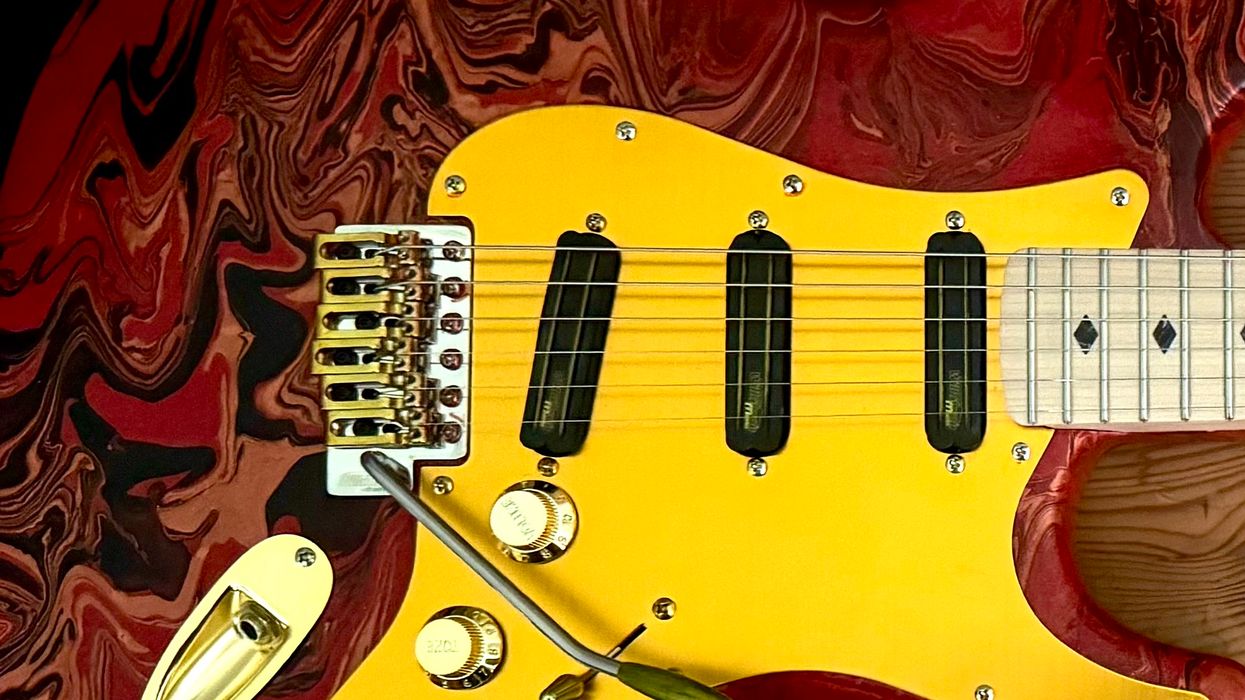
Reader: Cary Cummings
Hometown: Seattle, WA
Guitar: Catocaster
“The problem with cats is they get the exact same look whether they see a moth or an axe murderer.” —Edgar Allen Poe
Leroy had the courage to live on this earth for 19 1/2 years.
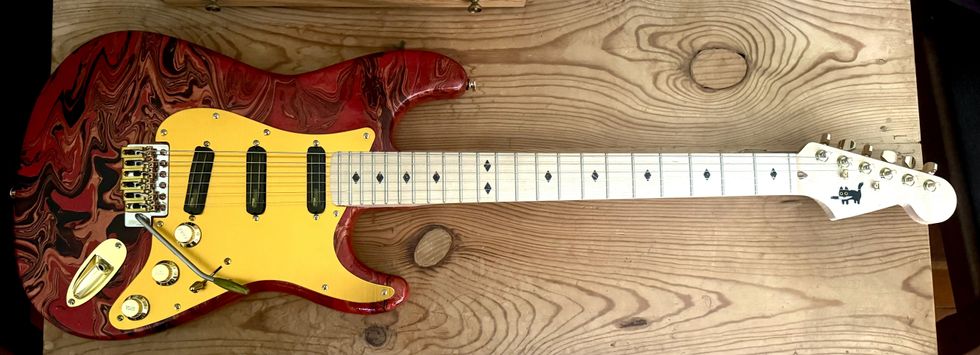
I had no idea what to expect when we arrived at the live animal will-call area at the airport. I knew I was picking up a 12-week-old Burmese kitten. When they brought out his little crate carrier, I was nervous and excited. But when I opened the door to peek inside and greet our new arrival, I saw a shockingly tiny, scared little creature that could fit in the palm of my hand, and I felt so bad that he was put through such an ordeal. He seemed pretty calm about the whole thing.
“Leroy liked flashy things, chaos, and movement.”
At his full-grown eight pounds, Leroy was the patriarch of our household and animal family. Over the course of his days, he lived and played with six different labrador retrievers, outliving three of them. He was everyone’s buddy and tormentor in equal measure. He slept on his bed when he wanted, curled up on a dog’s tummy, or on one of our heads. He loved to play fetch, knock over unattended glasses full of water, and relished a 90 mph sneak attack as we descended the stairs. He loved us, but often reminded us that we really lived in his world and he could take us out at any time. If he had been as big as one of the dogs it would have been terrifying. Sometimes it was terrifying anyway.

I built this guitar to remember and honor Leroy. He liked flashy things, chaos, and movement. He also loved “helping” change guitar strings and occasionally trying to swallow them. This build consists of a S-style poplar body from Ultratouch Guitars in Texas and a Warmoth quarter-sawn S-style neck with a Clapton carve and 6150 frets. I sprayed the body with a primer coat, followed by apple-red satin, and finished it off with Rustoleum red glitter to give it some sparkle. To add interest and movement, and a little chaos, I dipped it into a 32-gallon garbage can filled with water topped with a swirl of Magic Marble paint, finally sealing it in with 10 coats of wipe-on poly.
The finishing touch included an orange anodized pickguard, Wilkenson/Gotoh VSVG tremolo bridge, Wilkenson low gauss, blade style pickups, 250k CTS pots, 0.015 uF ceramic disk capacitors, Gotoh gold tuners, and a dangerous cat decal on the headstock.
I like to imagine Leroy somewhere over the rainbow bridge playing with his friends: Charlie, Dewey, and Olive. I hope to find them again one sunny day. I know Leroy would approve of this guitar and probably give me another sneaky needle-toothed surprise attack to celebrate.
Rig Rundown Best Of: Legendary Gibson ES-335 Stories and Setups
From Tom Bukovac’s first-year ’58 to Larry Carlton’s iconic ’69 and Molly Miller’s well-worn ’78, this PG best-of Rig Rundown celebrates the artists who made the ES-335 their own. Hear Charlie Worsham’s Vince Gill gift story, Tim Pierce’s player-grade philosophy, and Sturgill Simpson’s stage-shaking tones—plus why so many pros trust this semi-hollow classic.
